#not me being like *goes to Europe* *comes back even more radicalized*
Explore tagged Tumblr posts
Text
Nothing like finding more reasons to be pissed at Thomas Edison
#me findingn out that Edison's pr campaign against teslas proposed higher voltage ac current system is why americas voltage is so low#not me being like *goes to Europe* *comes back even more radicalized*
0 notes
Note
☔
☔Is there a fic concept you have that you'd like to just explain and share because you're not sure you'll ever write it? If so, what is it?
Back when I was younger, I was even more ambitious than I am now when it comes to big projects. I would come up with these epic, sprawling universes with what would have to have been 40 chapter concepts, at least -- easily 150k fics, and, because I was young and earnest and didn't know what I was in for, I'd commit to them.
And one of them was a fic that was a sort of crossover between Dracula and its Icelandic translation, Makt Myrkanna. Now, Makt is an oddball -- you'll notice that while I said it's a translation...there's a crossover. The reason is that. Well. It seems that whoever was in charge of translating it...took some liberties. A LOT of liberties. A lot of major plotpoints were radically reworked -- Jonathan's time at the castle was RADICALLY different, with a single vampire lady with an epic backstory who talks to him several times instead of the three iconic "Brides" that we know now, a cult of....extremely unfortunate Victorian stereotypes of "less evolved" or "primitive" humanoids who conduct human sacrifice in Dracula's basement, Lucy is not actually killed (because the author of the Icelandic translation, who was working off the Swedish translation...seemingly forgot?), Van Helsing goes to jail, Jonathan's killed. (The cowboy lives.) It's BATSHIT.
And I wanted to write this epic, epic fic around the concept of the Countess, that vampire lady, and Lucy tearing shit up. You know, I wanted to show the Countess stepping in as a sort of makeshift sire/mentor figure and lover for Lucy, who is making the transition from becoming a society girl to a vampire, throwing off her preconceptions about society and morality, seeing them go across Europe (there was actually a brief reference to Polidori's The Vampyre) when they were in Greece, seeing them adapt to the end of the 19th century. Their central conflict would have come from the Countess, who had an abusive husband (in canon! Who might or might not be Dracula himself, the evidence is conflicting) who basically...locked her in her room with her lover until he committed suicide (it's implied she banged him to death, what an icon), not really wanting to admit that she loves Lucy, and Lucy trying to content herself with that. There would also have been a B line running across it of the Crew of Light as they tried to continue hunting them, with a grief-stricken, widowed Mina (because remember: Dracula killed Jonathan in the final encounter) eventually facing down both of them but being unable to finish them off, with the second to last chapter being a note from the Countess (whose name is revealed in the epilogue to be "Dolingen", from "Dracula's Guest") basically telling her that she wasn't a dumb shit like Dracula, she wasn't going to try to invade England, she's sparing her for Lucy's sake, and to leave her alone in turn.
There was a LOT of good stuff with this fic, honestly, there was a lot of potential. Honestly, I think that the initial sex scene between Lucy and the Countess (taking place near a corpse, because, as we know, I Cannot Write A Normal And Non-Unsettling Sex Scene) is still one of the best sex scenes I've written -- I was a 19 year old undergrad, taking classes on Monsters in Fiction, Serial Killers on Page and Screen, Crime in Fiction, Dangerous Journeys in Fiction (which gave me the chance to reread Dracula!) going batshit insane and horny in a way that I was never able to quite replicate as I got older and more self conscious, writing about two hot vampire ladies having sex. I was in heaven. Or Hell. And I did do a lot of research for it, down to checking which operas were performing at the Graz Opernhaus in 1908 just to make sure that, when they were staying there, the selection would be accurate. I read a lot of 19th century vampire lit from the time -- Polidori's The Vampyre, I reread Carmilla, Das Grabmal auf dem Père Lachaise by Karl Hans Strobl (....given the name and that he lived into the 1940s...don't look at some of the other things he wrote), Paul Feval's The Vampire Countess, Eric Stenbock's "The True Story of a Vampire", I really, fully immersed myself in the world of 19th century vampire lore.
And I made good progress on it! 10,000 words! It wasn't like I wrote two pages and was done with it. But the problem was, honestly, as time went on...It felt like it was dragging on too much, like I was dragging the slowburn, which felt artificial for the Countess' character in Makt Myrkanna. She DOES have a tragic backstory, but she is also someone who is clearly here for a good time. Too much angst, too much heaviness between the two of them. It was too...human, you know? In fact, the entire section after the initial meeting/Lucy coming into her own under the Countess' mentorship felt artificial and dragged out, there to fit a certain idea I had coming in rather than anything natural. And the beginning wasn't the part that I had written out. So...I think that there's something redeemable in there, I think it might be able to rise from its vampiric slumber one day, with sections of it modernized to my writing style now, but it's going to be some time, probably. Which is a pity because I do love the two of them together, they are probably one of my favorite F/F relationships that I've written even if I didn't feel like I did the dynamic justice.
12 notes
·
View notes
Note
i'm not a frev expert. and you seem to be approchable enough and to have read enough. i had a question, or kind of a question. i just. i think that if robespierre wasn't against all the deaths by guillotine, he wouldn't have written that quote about virtue and terror. maybe i'm getting you wrong, or i'm not understanding the sense of that quote. could you explain?
Oh dang. I'm kinda surprised that people think I have any real authority on the subject of the Frev since I'm not an actual historian or anything and I'm surprised people find me approachable but of course I'll try my best for you Anon! And if anyone else has a better interpretation or anything else to add please, go ahead. I'll also try my best to keep it in as simple language as I can. But I digress.
⚠ This post is quite long so be prepared for that ⚠
First of all, Robespierre has more than one quote talking about terror and virtue. I'm assuming that you're thinking of the one that goes, "Terror is only justice: prompt, severe and inflexible; it is then an emanation of virtue; it is less a distinct principle than a natural consequence of the general principle of democracy, applied to the most pressing wants of the country." since that is the most common one. However, if you're talking about the one that goes "Terror is only justice: prompt, severe and inflexible; it is then an emanation of virtue; it is less a distinct principle than a natural consequence of the general principle of democracy, applied to the most pressing wants of the country." Let me know and I'll write about that one. The former is definitely a quote that, in my experience studying the Frev, gets misinterpreted from what it was originally meant to say fairly often.
To start with, it's very important to know what connotation and definition the words 'virtue' and 'terror' had in revolution-era France. Modern-day definitions may not be the same ones that were used in the past. According to my research, which of course isn't infallible, virtue was used to refer to someone's disposition and the way it would lead them to choose good over evil whereas where terror was seen simply as great fear. At the time there was no connotation of our modern-day terrorism to associate with the word. Nowadays we associate terror with terrorism which brings to mind murder, mindless destruction, oppression, and unchecked authority in which someone's ideals are forced upon large groups of people. Because of this many people assume that this is what Robespierre had in mind when he referenced terror when really he meant to describe the use of intimidation tactics to seize power from those who oppressed the lower class people and the general fear that was felt by the commoners.
Essentially the Reign of Terror meant 'a time period where everyone felt a sh*t load of Fear over all the bad stuff happening at once while the regular people try to overthrow the oppressive ruling class with intimidation tactics.' It does not mean 'a time period where loads of people were purposely committing widespread acts of terrorism to push their agendas'. And really, it was the only way to give everyone the chance to get rid of the old government, the monarchy, and allow a fair democracy that would be beneficial to the future of France to be built.
Next, it's important to know the context in which this quote was originally said. The speech where Robespierre said it took place on Feb 5th (?) of 1794. By this point, the revolution has been well underway for several long years and, as I said, a lot of sucky things are happening at the same time. The republic was in a war with a massive part of Europe and they're kinda getting curb-stomped. The country is in a state of civil war between the people that still supported the monarchy and all the different groups that had different views of how the country should be run. France's economy was complete sh*t too, so all this really radicalized the people and made the whole revolution situation so much worse than it already was.
At the time there were two factions, so to say, in the National Convention that were hella pissed at each other and really at odds. the Hébertists (who, to make things easy, wanted to escalate the Terror, go on the offensive with the military, and the overthrow and replace some of the existing government structures at the time) and the Dantonists (who wanted to sorta get rid of the revolutionary government, negotiate for peace in the war, and chill out on the whole Terror thing). And remember that these groups of people were very loose and like people in today's politic didn't agree with every stance their 'faction' took.
By the time Max made this speech, which was addressing these two groups, the situation between them was escalated big time. The Hébertists, with their views of 'more terror all over! That'll help us win everything,' or 'terror without virtue,' were pushing for a system that would quickly prove fatal. By contrast, the Dantonists with their, 'we just need to kinda chill and things will work out,' way of thinking or 'virtue without terror', would only lead to them (and the rest of the country) getting walked over by everyone else.
Throughout the entire speech, a speech I haven't recently read all the way through, Max comes back to the idea of terror and virtue, stressing that both are necessary. What I think he meant to do was talk about how the revolution couldn't survive without both terror (fear and the aggression that causes it) and virtue (the choice of good over evil) being applied. He's trying to explain to both groups that a little bit of both ideals is the most beneficial way to go about things. In reality, it has nothing to do with whether he personally believed in or advocated the death penalty/ the use of the guillotine. Instead, Robespierre is emphasizing that at that particular moment in time doing what is right and good (virtue) will most likely end up causing some bad things that will make people afraid for a while (terror).
What Robespierre is not saying is that terror, and by extension the violence that is causing the terror is virtuous. There are several easy-to-find sources that prove his personal disapproval of the death penalty from a moral standpoint. As a young lawyer in his hometown in Arras, he became physically ill at the idea of having one of his clients sentenced to death, even though he was found guilty of the crime he was on trial for. He made a speech agreeing with the abolition of the death penalty on May 30th of 1791 (?) arguing that there is no place for the death penalty in a civilized society because the law needs to be a model of what is good. He attempted to save the lives of Georges Danton and Camille Desmoulins, two friends/coworkers that he is commonly charged with sending to their deaths when the opposite is actually true. Additionally, he did the same with other more controversial people including the king's sister of all people, Madame Elisabeth. Even when voting for the death of the king he reiterates his own opinion on the death penalty saying, "For myself, I abhor the penalty of death that your law so liberally imposes, and I have neither love nor hatred for the King; it is only the crimes that I hate…. It is with regret that I utter this baneful truth…Louis must die in order that our country may live." Though it conflicts with his personal views, Robespierre makes the decision based on the needs of France as a country, something that many politicians need to relearn how to do today.
Long story short, he was not supporting the use of the guillotine with that quote, but rather trying to get two opposing factions to realize that both intimidation/fear and making sound, beneficial decisions would keep France on the right track to building a successful democracy for the people. Hopefully this helped and I explained it in a way that was easy for you to understand. If you ever have any more Frev related questions feel free to ask and I'll do my best to answer or I'll send you in the direction of someone else more knowledgeable if I don't know.
Also, can someone tell me if I did a good job of explaining this? I can never tell if things I write about the Frev make sense to me because I actually know exactly what I mean to say so everyone else kinda goes along with it or if I actually say helpful things of substance. Thanks guys! And if anyone else knows more about the subject or if I've made a mistake please help me out.
~Dara
#french revolution#robespierre#frev#maximilien robespierre#history#history facts#historical quotes#politics#my idiot explanations#idk if i worded this right#or if i even explained it right#i hope i helped though
35 notes
·
View notes
Photo

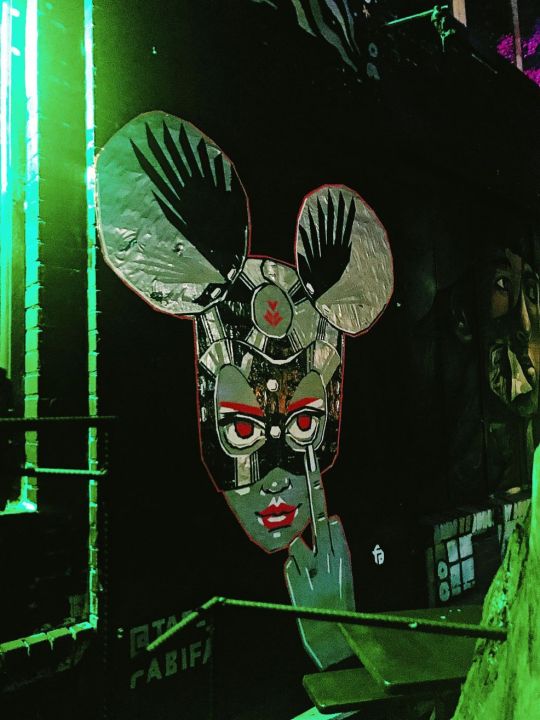








Tender Run Through Memories: You are crazy, my child. You must go to Berlin (2018)
extracts from a Berlin travel guide i worked on during my first internship. i was spellbound by Berlin’s entrancing mix of rich culture & gritty club-scene. i fell in love with the city, bit by bit, and i spent one month reviewing its art, museums and vegan food. during my time there, David Bowie kept ringing in my ears, as it was one of his soul-cities 🌼 you got the width of my tongue name on the sun 🌷 velvet goldmine, you stroke me like the rain, snake it, take it, panther princess you must stay 🦋
Feature: Introduction to Berlin
Much has been written about Berlin’s blend of history, outstanding culture and infamous nightlife. Proclaimed the capital of cool, Berlin is where you can “go to all-night parties, attend a screening of an arthouse film and an anti-Trump demonstration within 24 hours”, as The Times noted. Some talk about Berlin’s fall from grace, wondering if the city’s growing popularity diminished its authenticity and turned the city into a growingly expensive tourist trap.
From Marlene Dietrich, who sang “I still keep a suitcase in Berlin” with a piercing longing, to the rebellious singer Iggy Pop, who called Berlin his home, many artists have voiced their love for Berlin.
“You are crazy, my child. You must go to Berlin” (Franz von Suppé)
Affordable, buzzing, wild and carefree, Berlin is a symbol for tolerance and open-mindedness. Unlike other metropolises in Europe, it’s a place where you can relax. Berliners do not rush. They take their time, basking in the sun with their low-cut T-shirts and heavily tattooed arms, flicking back their occasionally bright-coloured hair.
Nights in Berlin are freaky, intense and fiery. The club culture is exhilarating; anything goes. Berlin is a techno capital: notorious DJs, outrageous raves and 36-hour long parties. There are plenty of clubs to choose from, perhaps the most infamous being Berghain, which pays the same taxes as theatres and concert halls, as it is considered to produce work of cultural significance.
It’s magical to lose yourself in Berlin’s night scene, in the hazy beat of electronic music and in the half-clothed masses. There is a strong sense of acceptance. You are free to be yourself. You won’t be judged.
________________________________________________________________
“Berlin, the greatest cultural extravaganza that one could imagine” (David Bowie)
Berlin is a home to artists and a paradise to emerging creators, who come here to pursue their dreams. There are around 20,000 artists living and working in the city, lured by cheap rents, the city’s libertine energy and the massive studio spaces. The street art mirrors the city’s fantastic art scene.
Berlin is bursting with culture and history. It has 175 museums, even more than New York. It’s an open museum too: from the Berlin Wall to Checkpoint Charlie and to the Nazi book burning site at Babelplatz, Berlin’s unique history can be seen by foot.
________________________________________________________________
“Berlin is cheap, but sexy” (Klaus Wowereit)
Berlin is the cheapest capital city in Western Europe. While it is getting expensive, perhaps because of its touristy appeal, it is the perfect place for backpackers, artists and adventurers for now. You can get a cup of coffee for €2, a lunch for less than €10, a pint of beer for €2-4, a day travel pass for €6,50 and a decent double room in a hotel for €50 per night. What is more, some of the attractions of Berlin are free, such as East Side Gallery, Raw Tempel and Yaam Beach.
_______________________________________________________________
Paris is always Paris and Berlin is never Berlin! (Jack Lang)
Nonetheless, Berlin is constantly changing, you never know what to expect. You need to experience it yourself.
________________________________________________________________
Reviews: Art, Beauty & Vegan Food
Beyond Compare: How African and European Sculptures Carve the Essence of Humanity
There are few exhibitions as fascinating as Bode Museum’s “Beyond Compare”. “Beyond Compare” brings together, compares and analyses the sculptural traditions of two continents by displaying, side by side, 70 African sculptures, along with renowned masterpieces from Byzantium, Italy and central Europe.
Despite their radical stylistic differences, it is interesting to observe how the artworks touch the same themes. They illustrate the frailty of the human experience, exploring subjects such as death, beauty, motherhood, power, spirituality and love. Cultures apart, humans seemed to be moved by the same matters; it is remarkable to see the dainty, gothic sculpture of Madonna, Virgin of Mercy, appear next to a seemingly raw sculpture which represents a power figure from Congo. The second sculpture looks quite crude next to the carefully-carved Madonna, but both were made with the intent to ask for protection, to invoke forces that are beyond the physical world.
In the exhibition’s first slide, it is noted that the works displayed were made by human beings, and not by “cultures”, “tribes”, “ethnic groups” or “nations”. It is important to keep this in mind while strolling through the museum, as this exhibition is not an objective comparison between two different cultures, but a soft reflection of human nature.
Address: Am Kupfergraben, 10117 Berlin. Closest stations: Friedrichstraße, Hackescher Markt; Bus TXL Staatsoper, Lustgarten, Friedrichstraße. Opening hours: Monday – closed; Tuesday, Wednesday, Friday, Saturday, Sunday: 10:00 – 18:00; Thursday: 10.00 – 20.00. Prices: 12,00 EUR, Reduced 6,00. Website: https://www.smb.museum/museen-und-einrichtungen/bode-museum/home.html Contact: Tel 030 266 42 42 42
______________________________________________________________
Enjoy the silence in Museum der Stille
Museum der Stille (“Museum of Silence”) is a unique invitation to embrace the silence in the middle of the lively district of Berlin Mitte. It’s a small, free and beautiful exhibition of paintings and architectural models that illustrate different stages of stillness. It is lovely, subtle and, above all, silent. In the middle of the museum, there is only one piercing painting of a woman who’s gazing through you, with a simple wooden bench in front it. The walls are a deep, warm red and the light is dimmed. The profound silence makes the experience sincere and intense; you are struck by a strong feeling of here and now. While at the beginning you might be put off by the awkwardness of hearing your feet clumsily shuffling through the museum, you will gently ease into the museum’s serenity, if you let yourself. For once, you do not have to rush. It’s enough just to take it all in.
Even after leaving the museum and walking back into broad daylight, the spell of silence is not broken. You might be finding yourself humming Depeche Mode and thinking that they were right, perhaps. It is enough just to enjoy the silence.
Address: Linienstraße 154A, 10115 Berlin Closest stations: Oranienburger Tor, Oranienburger Straße. Opening hours: Tuesday - Sunday 14:00 - 19:00 Prices: Free Website: http://museum-der-stille.de/de/ Contact: [email protected] Tel: +49 (0) 30 278 919 90
________________________________________________________________
CWC Gallery: exploring the modern and the contemporary
If you have a soft spot for art, but find most museums to be too sombre and a little old-fashioned, CWC Gallery might just be the place for you. “CWC” stands for “Camera Work Contemporary” and, as its name suggests, it focuses on contemporary and slightly modern positions found in photography, painting and sculpture. The gallery is in the heart of the bohemian Berlin-Mitte quarter and, while stylish and elegant, it isn’t pretentious and it has an easy-going vibe. It’s also completely free!
The first floor is a homage to the 1990s that recreates the dreamy allure of the era. Wandering around, you are charmed by goddesses of the ‘90s: photos of the iconic Iman, Gisele Bündchen, Uma Thurman and Halle Berry, all captured by Micheal Comte, are plastered on walls. Their half-smile and bouncy curls will leave you longing. You can soothe your temporary nostalgia by moving onto the next floors, where you can admire a beautifully curated and impressive exhibition of modern works of art, some of which display a striking social commentary.
In the same building, you can also find quite an interesting permanent exhibition about The Kennedys, which explores the political success and the private life of John F. Kennedy. The admission fee is 5€.
Address: Auguststraße 11–13, 10117 Berlin Closest stations: Oranienburger Tor, Oranienburger Straße. Opening hours: Tuesday to Friday 10:00 -18:00 Saturday 11:00 – 18:00. . Prices: Free. Website: https://camerawork.de/ Contact: [email protected] Tel 030 24048614
________________________________________________________________
Yoyo FoodWorld: the oldest vegan fast-food joint in Berlin
Yoyo FoodWorld is a hip fast-food joint on the Gärtnerstrasse 27 and the first and oldest vegan fast-food in Berlin.
For almost ten years, Yoyo hasn’t been your typical fast-food. Its atmosphere is similar to one of a quiet, cozy indie bar. Indoors, the light is slightly dimmed and there are photos of famous musicians and philosophers plastered on the restaurant’s walls, along with cult film posters that would make any film student swoon. Soft rock music plays in the background. The outdoor sitting is just as delightful, as the area surrounding the joint is lovely and inviting.
The food is cheap, fantastic and sure to satisfy your cravings, as the options are varied. They have 3,50€ burgers, 6,50€ pizza, 5€ wraps, 6€ schnitzels, 5€ seitan Currywursts, 3,80€ sea food and meatballs at the price of 8 for 3,20€. All the dishes are deliciously vegan and would work perfectly as comfort food or hangover food. It’s also the place to take your friends to convince them that vegan food is tasty.
Another highlight is the toilet, which is exceptionally cool. It’s filled with queer stickers, feminist and political statements, colourful graffiti and carefully scribbled love poems; ideal for a quirky Instagram post.
Address: Gärtnerstraße 27, 10245 Berlin Closest stations: Samariterstr., Frankfurter Tor, Warschauer Str. Opening hours: Monday- Thursday 12:00 - 23:00, Friday - Saturday 12:00 - 00:00, Sunday 12:00 - 23:00. Prices: € Website: http://www.yoyofoodworld-berlin.de/ Contact: [email protected]
______________________________________________________________
Get fettundbetrunken at the Chaostheorie
Chaostheorie is the first vegan cocktail bar in Germany. Their slogan is “fettundbetrunken”: “fat and drunk”, so expect to find a perfect mix of cheap comfort food and funky alcohol.
Onto the first part of their motto, “fat”: the food is fantastic. From a veganized traditional cuisine to more modern dishes, the highlights are juicy currywursts, enormous doner kebabs, fries with dripping dips, pulled mushroom burgers and thick cheese meatball sandwiches. To sweeten things up, the selection of house-made cakes is flavourful to say the least. The Oreo cake, smooth and crunchy at the same time, is a popular favourite. The soft drinks are also a dream: creamy milkshakes, Snickers, Manner or Oreo flavored, and rich freakshakes. You can settle for classic options, too: late macchiato, hot chocolate with whipped cream and marshmallows, coffee with caramelized milk and hot applesauce with cinnamon and vanilla soya milk.
Now, onto the second part of their motto…”drunk”! You can sip traditional cocktails or try out the bartender’s specials: experimental and refreshing mixtures such as Julep Blue, bourbon, blue curaçao, ginger ale and limette.
The place itself is cozy: dim light, soft indie music, shelves stacked with books and a lovely photobooth perfect for making memories.
Even if you’re looking for a quiet afternoon with good food or for a tipsy evening, in Chaostheorie you can find the things you thought you’d never enjoy again once you went vegan.
Address: Schliemannstraße 15, 10437 Berlin. Closest Stations: Prenzlauer Alle, Stargarder Str., Schönhauser Allee. Opening Hours: Mon, Tue, Wed: 17:00 – 22:00; Thu: 17:00 - 23:00; Fri: 17:00 - 01:00; Sat: 15:00 - 01:00; Sun: 15:00 - 22:00. Price range: € (under €10). Website: http://www.chaostheorie.berlin/ Contact: 030/548 907 34; [email protected].
_____________________________________________________________
Challenge yourself at the Kunst-Werke Institute for Contemporary Art
The Kunst-Werke Institute for Contemporary Art is a remarkable contemporary art institution located in the Berlin’s picturesque district Mitte. The building is a sight itself and it has a sophisticated allure, tall and elegant. The outdoor café has a lovely Parisian appeal and it’s where the hip tattooed artists you might have seen on Tumblr sip their coffees in the afternoon.
The works of art exhibited in the Institute are complex. You can marvel at political activist art, video art, visual art or interactive art. They’re also controversial, with people either excitedly praising them or dismissing them as meaningless. The exhibitions are divided into rooms: in some rooms you might be deafened by booming nature sounds, while in others you might be asked to take off your shoes and wander into an empty, soundproof room, where you’d be faced with a gut-wrenching documentary about the condition of the modern black artist. However, you never know what to expect, as the exhibits change constantly. Nonetheless, the works of emerging young artists are unique and do not hold the reassurance of traditional art: they challenge you and shake you. They draw out a strong response, be it positive or negative.
Finally, even if you occasionally roll your eyes at modern art, you should give the KW Institute a chance. At least one of the works of art displayed might move you.
Address: Auguststraße 69, 10117 Berlin. Closest stations: Oranienburger Tor, Oranienburger Straße. Price: 16€ general entrance, 10€ reduced. Opening hours: Monday: 11:00 – 19:00. Tuesday: Closed. Wednesday: 11:00-19:00. Thursday: 11:00-21:00. Friday, Saturday, Sunday: 11:00 – 19:00. Website: https://www.kw-berlin.de/ Contact : +49 30 243459-0, [email protected].
______________________________________________________________
Be Here, Be Queer at the Schwules Museum
The Schwules Museum is the world’s first gay museum, originally opened in 1985. It exhibits the violent history and the injustices the LGBTQ community endured in the past, as well as Berlin’s current queer life.
Schwules is not your typical queer museum. If you expect it to be bustling with colour and rainbows, you might be taken aback. To an extent, it is exceptionally colourful, with cheeky illustrations of young gay couples kissing, soft porn photos and neon slogans about love. But a more serious tone is predominant. The permanent exhibitions also depict gay history milestones, such as the feminist revolution, the composition of the first feminist songs of the German movement or the protests of a working group of lesbian teachers. In the middle of the museum, there’s a memorial dedicated to the LGBT people who were killed in concentration camps. Their names are written in blood-red. You will also shudder upon entering the museum, where you can see a lengthy list of countries where homosexuality is currently considered a punishable crime.
It is important to go to the Schwules Museum because you will be reminded of how painful history is and how the free world we live in required sacrifices. And how, for some, the world still isn’t free.
It is not allowed to take pictures, which at first might be quite annoying, as your initial impulse might be to want to immortalize everything. However, this might help you take in all the information and carefully weigh what you’re seeing.
Finally, is important to go to the Schwules Museum because you will be reminded of how painful history is and how the free world we live in required sacrifices. And how, for some, the world still isn’t free.
Address: Lützowstraße 73, 10785 Berlin Closest Stations: U Nollendorfplatz, U Kurfürstenstraße, Lützowstraße / Potsdamer Straße, Lützowplatz. Opening hours: Monday: 14:00 – 18:00, Tuesday: Closed, Wednesday: 14:00 – 18:00, Thursday: 14:00 – 20:00, Friday: 14:00 -18:00, Saturday: 14:00 – 19:00, Sunday: 14:00 – 18:00. Price: € 7.50 regular, € 4 reduced. Website: https://www.schwulesmuseum.de/ Contact: 030 69599050
______________________________________________________________
Sun and wholesome food at The Bowl
The Bowl, self-proclaimed a “clean-eating restaurant”, is the perfect place for a cozy lunch with your friends or for a breakfast date with a book. They only use fresh, seasonal, healthy and gluten-free products. Everything is fully sustainable and vegan. They even use natural sugar! And, truthfully, the food is indeed full of flavour and it leaves you with a sense of freshness. They have a great variety of bowls: from rich breakfast bowls filled with sweet fruit, raw chocolate and creamy soy yoghurt to lavish plates with roasted vegetables, mashed avocado raw crackers, zucchini and smoked paprika.
The desserts are a treat, as well. The highlights are the lush vanilla almond cake, with coconut blossom sugar, raw chocolate and coconut strawberry and bananenbrot, with grilled banana, granola, warm strawberry sauce and raw chocolate.
While it is a bit pricey, 6,50 € for breakfast bowls and around 10 € for the lunch specials, the naturalness of the food, its filling base and vitamin-rich toppings make it all worth it.
The dishes are perfectly Instagrammable and the colourful variety of vegetables and legumes doesn’t even need a filter. While enjoying your wholesome food, you can bask in the sun in front of the large windows and observe the buzzing Warschauer Straße, with hazy, synth-pop music unfolding in the background.
What is more, on the ground floor of the same building where Bowl is, you can find Veganz, a plant-based supermarket with an impressively wide range of products, from cheese and ham slices to cashew cookies, ice cream and the finest chocolate cream.
Address: Warschauer Str. 33, 10243 Berlin Closest Stations: Warschauer Str. Opening hours: Monday: 10:30-23:00, Tuesday: 10:30–23:00, Wednesday: 10:30–23:00, Thursday: 10:30–23:00, Friday: 10:30–23:00, Saturday: 10:00–23:00, Sunday: 10:00-23:00. Price: €€ Website: http://www.the-bowl.de/ Contact: 030 29771447
8 notes
·
View notes
Note
I'm from a country that's also been going through an inmigration boom since a while. I used to be super chill about it when young, and thought everyone against it was a racist/xenophobe or close minded. But then, as more people started emigrating here, I realized things aren't that simple. Crime has skyrocketed since then, from robbery to murder. There have been more kidnappings than before, and many women have been drugged on the subway or bus. There's also new forms of crime, specially theft related, that weren't common or simply didn't happen before.
Now I'm not trying to say every inmigrant is this way, there are many who are super hardworking and come here because they want to find better opportunities that their origin countries couldn't give them. Some are even nicer than the locals honestly lol. But many of those responsible for these crimes are unfortunately inmigrants, and since some dont even have papers it's harder to identify them.
And even things that are more neutral, like ways of living and habits can cause problems. Like for example inmigrants from some countries are known for being loud and constantly having parties. And this bothers locals that are not used to so much noise.
This is why I don't blame Poland for being willing to take refugees from Ukraine and not from. Because Poland has more similarities with Ukraine, like with religion and traditions. However, the other are mostly Muslims and growing with Islam as a religion will shape your views, values, morals and behaviours, like you mentioned how they view women for example. Same goes for African countries being unwilling to help Ukraine. Like each country government should prioritize the safety and interst of their citizens first and foremost.
Yeah I 100% agree with you.
I think most people aren't bothered by immigration by itself but rather by the immigration of individuals creating trouble and from cultures clashing with locals'.
It's important to note that immigrants causing trouble are for the most part illegals resorting to petty thief to survive. That's why I don't understand why people from LEGAL immigrant families get so defensive about illegals projecting themselves onto them. We're not the same lmao My parents would have NEVER put my family in danger in a dangerous trip just because they wanted a good life in Europe. Actually my dad went back to Congo after their divorce and the only reason my mom stayed is bc my sister had a genetic illness that was not properly treated in Congo (even today it's legal to abort babies with the same illness as her....)
Beside, Congo is a country 90% Christian (with only 1% Muslim) so no, I don't see myself in illegals from countries where it's okay to harm women because their religion says so... There's a lot of issue in Congo, but women can work, aren't forbidden to go outside if unsupervised, or are forced to cover themselves from head to toe... As a Christian I'll always feel less threatened by a fellow Christian immigrant than one coming from a country whose religion allows harming female. Period.
Illegals are people who had nothing to lose in their country of origin. They do not represent the average citizen of these countries who have a family to provide for, are socially integrated, and would never take the risk of dying while crossing the Mediterranean sea for some fleeting European dream... That's what many racists/racial essentialist fail to understand. For them, the illegals from said country are representative of every single person of this country - when illegals by themselves are a specific demographic. If they couldn't manage to integrate socially in their own country, why would they anywhere else?
That being said Islam is a real issue which does not simply depend on someone social status or whether they're illegal. Here in France, even french citizens are getting radicalized (with the internet) and many statements in the Qran (so independently of individuals) make me uncomfortable. I've had many lovely Muslim friends though and they mostly seemed to endorse a Islam lite™ unaware of the most radical parts of it, so I don't think every Muslim is a potential terrorist either lol it's just that Islam becomes dangerous once properly applied.
Personally I wish immigration laws were stricter because beside creating criminality, those illegals are creating a disservice to legal immigrants who are (for the most part) not creating problems.
You're right, Poland is right for standing its ground and not letting anyone enter their country unchecked. I don't understand where the entitlement of these illegals come from...and all the people painting them like poor victims. Only women & child should get some sort of protection or help, but men need to get a grip. Just look at Afghanistan : these men were so quick to flee from the Taliban, leaving women to be treated like objects....
I got crap a few months ago for saying Western countries were right to favor Ukrainian refugees and that it wasn't the same as when men from countries that weren't even at war where flocking here just because they felt entitled to lol Especially when said men come from countries where women are poorly treated and get routinely thrown acid at or lashed as punishment... Sorry but I refuse to be anywhere around such people and Western countries are right to pay them dust.
I think if Europe was banning Muslim MEN from immigrating (I don't mind women and children) it would improve born the image of Islam because it's always the newly immigrant promoting the worst type of Islam and creating trouble because they can't behave around women.
1 note
·
View note
Text
WIP wednesday thoughts:
willow cabin is utterly fucked because i changed my intended ~moral~ halfway through and now im stuck trying to integrate this shitty political intrigue plot into what should’ve been a more interesting story about éowyn adapting to life in gondor. hugely fucking annoyed by it and just totally unsure how to proceed. i could significantly increase the chapter count, but im worried that because the initial framing device was this bandits shit that closing out that plot and then still going for ages afterwards would be really shitty? i honestly don’t know, it’s so difficult. really i just need someone to read my outline and tell me if im being a dumb twat about it lol
meanwhile I know exactly where I want to go with AFTA but for some unaccountable reason im stressed that my ass is gonna get roasted for the direction i want to take it in. it’s all based in both tolkien’s personal politics and (some) historical precedent, but im worried people are gonna see it as a marysue-ification? but also im hoping to do sthg of a sequel to afta to practice the political intrigue writing so i don’t make the same mistakes i did in wc, and to do that it would require this specific set up in AFTA. im gonna put my AFTA thing under the cut so don’t click read more unless you’re gucci with potential AFTA spoilers!!
this royal affair au is definitely gonna get published at some point but im trying to decide if i want to do ~tasteful~ smut that drives a longer narrative or if im really just gonna do a whole 3,000 word build up to some run of the mill, old fashioned PWP lmao
okay so i have spent a Lot of time thinking about what impact i think éowyn and faramir would have on each other in a pre-ring war setting, and the honest to god conclusion ive come to is that they would somewhat inadvertently egg on each other’s (wildly divergent) idealism.
faramir’s an idealist politically in ways that, as Big D rightly points out, are not super productive in a wartime scenario. but so far as im concerned, the war doesn’t feel as warlike until they have to blow the bridge at osgiliath. until that point, there’s not really anything to say that faramir’s whole throwback optimism isn’t a perfectly justifiable position to have.
but what that idealism is and how it manifests are two really important considerations. the crux of his idealistic politics is that he looks at númenor and sees something valuable in it, and looks at gondor and sees a lot that he thinks is fucked up. outside of articulating a general angst towards the glory hunting, it’s not like he’s spending time talking about his specific policy prescriptions. however, we do know a few things that can guide us to a more coherent reconstruction of his politics:
he’s pretty rigidly hierarchical (when it’s convenient for him). as seen in: him basically telling sam to fuck off and stay in his lane in WOTW, and in how and when he chooses to refer to his father as ‘father’ vs ‘my lord’ or ‘lord of the city’ in the aftermath of the osgiliath retreat and then before he gets his ass sent back there. i don’t want to go into too much detail here but if i go with this i’ll definitely justify it more thoroughly in the footnotes.
so we’ve got faramir’s emphasis on hierarchy and his occasional (when convenient) belief that the upper echelons of a hierarchy are there because they’re intellectually and/or morally better. or, maybe to remove the causation from that instance, because they are in those upper echelons, they have an obligation to be more morally/intellectually upstanding, and the people in the structure below them have an obligation to show deference. unless you’re faramir and you’re dealing with denethor in which case that all goes out the window. classic.
we know there is some sort of nascent pseudo-democratic tradition of popular sovereignty in gondor. we know this because faramir asks the masses at aragorn’s coronation if they’ll accept him as king. faramir is a lot of things, but he is certainly not a progressive political radical, and i cannot imagine any situation in which he cooked up that rigmarole himself. that then implies to me that it’s building on some sort of political/cultural expectation in gondor. so: some sort of relationship to popular legitimacy. the people of gondor are subjects, but perhaps not as totally passive and unconsidered in the power structure as we might assume given the comparability to feudal europe/asia.
given those two things, i want to use AFTA to argue:
that faramir, in looking to assign blame for the faults he sees in gondor, would not directly assign blame to the lower classes, but rather to the aristocracy, because he will have seen them as failing in their moral obligations to the people they rule over. this is not to say that he isn’t fucked off about The People™ valorising war, but i think he’d take the position that they couldn’t possibly be expected to form those values and opinions of their own volition, and the fault lies in their rules. faramir: not gramscian.
faramir lacks any power that is non-military, and even that is of questionable worth because the rangers seem to be fairly distinct to the general structure of the army, and are not exactly a huge force.
faramir lacking any political power isn’t necessarily a huge concern for him (as in, he’s not actively trying to change that), because he knows he’s not going to lead a moral revolution and isn’t interested in taking up the responsibilities having political capital would engender because he’s stuck dealing with this war, that he fucking hates btw has he mentioned that he hates it?
however, given that he is apparently eminently versed in lore and scholarship, he is probably keenly aware that there is this incipient notion of popular legitimacy somewhere in gondor’s culture. it’s not, for most of his life, knowledge that actually does anything for him, but it is there.
éowyn, meanwhile, doesn’t really have many strong political convictions (yet). not because she’s a dumbass or whatever, but because she looks at court politics as kind of a farce, and doesn’t believe that power legitimately emanates from anywhere that isn’t a Big Fucking Army. and why, strictly speaking, would she not think that? the event that brought about the creation of her kingdom was not careful, soft spoken negotiation, it was her ancestors being in the right place at the right time with a Big Fucking Army.
and the internal politics of the Riddermark actually seem to be fairly stable, all things considered. i sincerely doubt that Théoden or Théodred are having to negotiate complex politicking in the way Denethor and Boromir are. so where, then, would éowyn see that kind of political behaviour outside gondor? with gríma.
éowyn, then, will see the immediate contrast between gríma (backroom dealer, manipulator extraordinaire) and théoden (owner of Big Fucking Army). and gríma goes and fucking wins that fight. that forces éowyn to confront the fact that, jesus christ, maybe there are different types of power.
at the same time, she’s going to be in minas tirith and needing to cover for théoden letting his shit get wrecked. not just because she’s prideful, which of course she is, but because if denethor/gondor think that théoden is too weak to hold up his end of the bargain, why would they ever go help the Mark? éowyn, seeing that théoden’s f-f-fucked, knows that there’s a very very good chance the Mark will need help.
against her feelings about courtly politics, she starts to accept that she’s going to need to do something to get power in gondor. not anything substantial, it’s not like she’s trying to overthrow anybody, but enough that when push comes to shove she can force denethor to help out the Mark (if he doesn’t do so willingly).
but, as ive sort of already shown in AFTA, she’s a bit of a dogshit diplomat. good for a little big-brawny-enforcer stuff, but not exactly brimming with cultural sensitivity. by the time she realises théoden + the Mark are fucked, she’ll have burnt quite a few bridges with the gondorrim nobles, and it’s not like she’s the sort of person to go running cap-in-hand begging for mercy.
so: she has to look elsewhere. and wow! a chance for faramir to do his favourite thing — talk about his opinions! and by god, his weird idealistic politics are… actually kind of helpful? because he’s like, look, you’re never gonna be a diplomat, but there are other ways of consolidating power. and one of those ways is by appealing to The People™. so why not work that angle?
and actually, we know that this is a viable route for éowyn because hama, in arguing for her to take up the mantle of théoden’s heir when théoden and éomer fuck off to helm’s deep, basically says that The People™ love her and would have willingly chosen her to lead them.
we also know, based on faramir’s middle men speech, that the people of gondor and the mark have grown alike in nature. not totally unreasonable to then think that the people of gondor would take to her like the people of the mark did.
éowyn, then, in various ways begins to try to win over the people of minas tirith. i need to do a little more research on this bc what ive got on the practicalities of that so far are a bit, uhhh, sketchy, but the least jargony way to describe this is to point to when natalie dormer’s character in GOT gets out of the carriage to go hug and kiss some babies. (marc bloch, eat your heart out)
this would later segue into a potential sequel where, while trying to secure the way for aragorn’s coronation, éowyn actually plays an interesting role because she’s fallen into this incidental Diana, People’s Princess™ role and so is better positioned than almost anyone to go advocate on his behalf. wow! cool! éowyn getting to be politically useful in more ways than just getting hitched!
so yeah. that’s how i am thinking it might play out. this would obviously have a rolling impact on the remainder of AFTA and how certain (🔥) events pan out later, but i think that building up part has to begin pretty much now, narratively. also this lets me get in a reference to “and then her heart changed, or else at last she understood it” and have it not be almost entirely about wanting to shag faramir, but actually about her gradual evolution from valorising war above all else to being like, hmm, maybe there are other ways of being powerful. which i think still largely captures the “no longer I will vie with the great riders” stuff, but more subtly and without feeling quite so… deferential, I guess? Like it’s not that she’s swapping one form of power (violence) for nothing (gardening?? healing?? tolkien accidental articulation of necropolitics??) but swapping violence for a different type of more sustainable power.
yeah. that’s the take, basically. who fucking knows.
6 notes
·
View notes
Text
3 years of Sonic Forces, the biggest love-hate relationship of the series
[note: this is the translation of @latin-dr-robotnik’s article]

Today is an almost special day, today it’s the anniversary of a rather peculiar game in this series.
On this day 3 years ago, the (to this day) newest game of Sonic Team was released: Sonic Forces. After waiting a year and a half since its announcement (and four years since Sonic Lost World’s release), it was finally time to see what the last chapter of the main series had in store for us, and the results were… okay.
There were so many warning signs in the months before the release: a marketing campaign that was noticeably absent until the very last month, opting to focus more on Mania (let’s not forget that we still get videos about Mania even after the game’s release, not so much about Forces), which added to the uncertainty caused by the footage already available at the time, which ended up being confirmed a few days before the release, when some people managed to get the game early and streamed a good chunk of the game. While one of the leakers was just a bad player, the quality of the game itself was put into question…
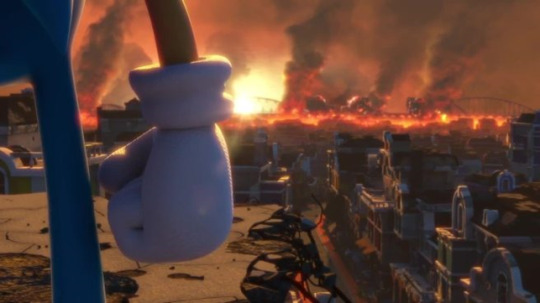
A harsh reality
I’m not going to soften up my words here: for being the latest Sonic game, in a post-Generations and post-Boom era, Sonic Forces fell short of everything it tried to do (if it tried). Anything positive comes from the roots of something negative, and in the context of this anniversary, after 3 years without knowing a thing about the next game, it only emphasizes the frustration and the disappointment it caused.
Sonic Forces promised a world devastated by Eggman, an epic battle to save the world and win against a powerful enemy. However, of so many promises, not even the first one, the most basic one, was kept: it was an empty takeover, explained poorly (because they didn’t even show it, they told it through text) and developed even worse. All the potential of such an exciting world was thrown away as soon as the game didn’t even try to explain some of its most important questions (like why Green Hill was in the process of desertification); to this day we still don’t know what the fuck does the Phantom Ruby do, in Mania it has some powers, in Forces it has different powers, and it’s not clear where does it come from or if it’s more powerful than the Chaos Emeralds. It is disappointing to not be able to discover all this untapped potential, and it is so disappointing that one of the oldest works on my blog was an attempt to rewrite the beginning of the game, give it more context and a better footing to start the adventure.

This old leak dates back to 2016, when the game was barely announced, and surprisingly it ended up being real, very very real. Even the title “Sonic Wars” is true, and if you don’t believe me you can open the game’s folder and read the names that appear. Source.
The confusion and disappointment don’t end here. If you have read the mess of opinions and emotions that is my analysis of the game [translator’s note: the link is in Spanish], you may have noticed that one of the biggest questions never answered was, what’s up with the order of the levels and why is it so confusing? Between 2016 and 2017, there were some leaks and statements going around places like Sonic Stadium that confirmed that the game went through numerous changes, not just in the plot, but in the levels as well. Right now I can’t find these old posts (I’m surprised that the fandom didn’t archive them), but it was said that the original idea for Forces, then still called Sonic Wars, was to shine the spotlight even more on the Avatar, or Buddy as it was called; the decision was unanimously rejected by SEGA of America and Europe, forcing SEGA of Japan to order that the game was modified. In fact, I remember that the leak that mentioned this meeting between the SEGA branches was rather bad, with a very tense atmosphere and lots of disagreements.
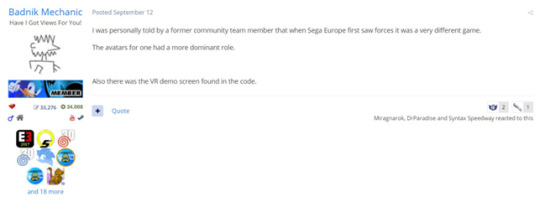
This is the closest thing to a confirmation of the scrapped plot that I could find. At least it’s proof that I’m not crazy and that Forces was indeed more focused on the Avatar. Source.
The mess that is the order of the levels, the questionable presence of characters like Classic Sonic, and some of the details of one of the leaked scrapped scripts such as that apparently they considered to reintroduce Mephiles – all of this shapes the network of a mediocre game, created under the premise of “from the creators of Sonic Colors and Sonic Generations” but taking all the wrong parts of those two games, using an engine that has been proven to be less efficient than Unleashed’s and Generations (and I’m not talking about the Hedgehog Engine, which is the graphical engine – I’m talking about the game and physics engine of Lost World), and with short levels and… polarizing bosses, to say the least.
The result is a game that shows a lot of potential, but in practice it doesn’t live up to it at all, be it for its own limitations (being rushed like hell) or for a noticeable lack of attention to details; it didn’t succeed in creating a cohesive and coherent world, with levels that could be worthy of what has been learned in these years. This is the reality of Sonic Forces.

And yet...
Despite everything I’ve just said, despite all the unacceptable errors that Forces made, and despite all the terribly wasted potential… we still talk about this game.
There are many reasons. On one hand, Forces and Mania have been the latest Sonic games for 3 years now, which is tragic in on itself (Team Sonic Racing disappeared from the face of the Earth); on the other, we still talk about Forces because there is something that still attracts us to it.
It’s not the same attraction we feel for Sonic ‘06, though. Forces is not a complete, almost-franchise-killing disaster like ‘06 was, it’s not a giant meme that spread from the fandom to popular circles and internet figures such as the Game Grumps. People have been trying to fix Forces’ mistakes, but not on the same scale as projects that tries to completely recreate ‘06 with a radically different engine, or fix each and every bug in the original version. Forces is nowhere near as infamous, and so the discussion goes in different directions.
youtube
Episode Shadow is still one of the most entertaining parts of the game, and one of the most important as well, as Shadow himself hadn’t been a playable character since… well, Sonic ‘06.
On one hand, there is a cult surrounding Infinite, one that I personally don’t agree with, and I don’t know if it’s bigger than Mephiles’ 15 years ago, but I do know that it exists and it’s still present. One of the ways Sonic Team tried to “go back to its roots” was to introduce a character like Infinite in a plot that was supposed to be “more serious”. Final results notwithstanding, Infinite managed to win the heart of a sizeable portion of the fandom, which still wishes for his return and development.
On the other hand, there is the Avatar, our personal OC with an impressive customization system, which allows us complete freedom, to the point that we could recreate characters introduced in Sonic IDW like Whisper the Wolf. What at first looked like a questionable idea, nothing more than a source of memes, ended up becoming the smartest idea Forces had, with a gameplay style that, in my opinion, retains a little of the old Adventure spirit, and even had some of the most fun levels in the game. While Classic Sonic ruined one third of the game, and Sonic was somewhat mediocre compared to his past feats, the Avatar’s gameplay style manages to keep its quality throughout the game, despite the fact that the plot keeps revolving around their presence instead of focusing on the other aspects of saving the world, which is... well, a little unfortunate.

Even I, who I’m not really into Sonic OCs, had a lot of fun recreating some of the characters.
And finally we get to the best part of the entire game: the music.
Even after three years my opinions haven’t changed much. Forces’ music isn’t perfect, it has its low moments (I feel like I’m the only one who doesn’t like Light of Hope) and some disasters (F*ded H*lls lol), but overall it has good intentions and it has some pretty good highlights.
The use of synths, as overdone and criticized as it is, was an honest attempt to follow a trend present in older games, like Sonic Unleashed, where this instrument symbolized Eggman’s influence. An interesting touch that, while wasn’t completely successful, is appreciated.
youtube
I still say that Fighting Onward is one of the best themes of the entire game, and Spaceport as the level benefits from having it.
Then there’s the best part of the entire soundtrack: the return of vocal themes, such as the main theme, the villain theme, and some of the level themes. I cannot explain with enough words how much fans were waiting for this, and it was brilliantly handled by the advertising campaign: a preview of the instrumental version of Fist Bump, a short peek of the Avatar themes, and finally the reveal of some of the major themes. It’s not surprising that it became one of the most appreciated parts by the fans. From the iconic intro of Fading World to the subtle nod to Green Hill in Set In Motion, every theme has something that makes it stand out from the rest of the game.
But even so, the rest of the music in the game has redeemable points as well. Forces in general distances itself from the music styles previously used in the series, especially from the variety of incredible sounds of Unleashed or even Lost World; but from time to time it still recognizably Sonic, like in the half-Megaman, half-Runners Network Terminal, in the extremely epic and underrated Last Judgement, or in the always-mentioned Ghost Town (not the only “good” Classic theme in my opinion, but the first one that comes to mind). Even the remixed Zavok theme sound better in Forces than in its original version.

A love-hate relationship
At the end of the day, the only thing left I could say is that Forces is still one of the most polarizing games in the series. 3 years aren’t enough to heal some of the wounds left by the 4-year hiatus, plus the disappointment of the time, but at the same time these 3 years kept alive the memory of its best moment, the discussions about the music and the uncountable groups of fans reunited to share OCs like the fandom has always done.
In this anniversary, I thought it would be interesting to revisit a bit the peculiar relationship I have with this game, as we wait for a new hype cycle for the next game. And maybe, just maybe, that will be the moment Forces will fade from our collective memory, at least for a decade, until new fans will look back to the good and bad this game has done. And I hope that, in the future, the situation of the franchise will also be different from what it has been these last years, in a good way of course.
This is all we have left of Forces today, a game that did not manage to capitalize on its opportunities, and a game that shames the legacy of the Unleashed-Colors-Generations era; but also a game that had some genuine, interesting ideas, and a different musical direction, one that (with some exceptions) was what the fans wanted. It’s a polarizing game, it’s a love-hate relationship.
#sonic the hedgehog#sonic forces#translation#happy birthday forces#i've translated this article because it sums up my thoughts pretty well#i don't hate it and there are things i unironically like about it#but overall it was a big disappointment
21 notes
·
View notes
Text
Doctor Who: Ranking the Master Stories – Which is the Best?
https://ift.tt/2ZLI4i2
Roger Delgado looms large over the character of the Master, being simultaneously influential and something of an anomaly: Delgado played the role with a debonair front, but since his death, the character has been less urbane and more desperate, manic and violent. In fact the actor who’s come closest to Delgado’s approach is Eric Roberts, who plays an American version of Delgado’s Master until his performance goes big towards the end of 1996’ ‘The TV Movie’.
Each actor brings different facets to the fore, but after the character’s successful launch in Season 8 we get the tricky balancing act of the returning villain: We know that the character returns because they’re popular (indeed, the reason for their existence was the question ‘What can we do to attract viewers for the season opener?’), but in story terms, this makes them seem increasingly ridiculous. The Master, among all Doctor Who villains, seems especially keen to involve the Doctor. Why do they keep coming back if they’re always defeated?
In recent stories, writers have attempted an explanation for the Master’s behaviour, be it an unspecified insanity or a damaged friendship where each party attempts to bring the other round to their way of thinking. Mostly, though, the Master appears in Doctor Who for a simple reason: a lot of viewers find it fun when the Master appears in Doctor Who, and the Master seems to find it fun when the Master appears in Doctor Who too.
Overall the character has a solid record in the show. Fewer classics than the Daleks, fewer duds than the Cybermen, but a lot of solidly entertaining stories mostly lifted by his presence. Here, then, is my ranking of – give or take – every Master story from the television series.
27. Time-Flight
I’m sure there are redemptive readings of ‘Time-Flight’, and its flaws are more understandable in the context of its production (with the money running out at the end of the series and a shopping list of items to include imposed on writer Peter Grimwade), but the end result is poor.
To contrast Anthony Ainley’s performance with Roger Delgado’s for a second: Delgado always played the Master with a calm veneer, as though his nonsensical schemes were perfectly sensible. As a result, he seemed in control. Ainley plays the role as if they’re not merely sensible but clearly brilliant plans even though they strain credulity. They’re smaller in scale and this makes Ainley’s Master seem tragicomic. He loses control more, there’s a kind of ‘She’s turned the weans against us’ desperation that’s much more apparent in this incarnation.
‘Time-Flight’ is, despite its faults, a poor example of this. While the Master disguises himself as a mystic for no clear reason, his end goal is simply freeing himself from prehistoric Earth. Once he’s discarded his disguise, Ainley’s performance is largely underplayed (especially in contrast with ‘Castrovalva’, earlier in the season). While there’s some camp value in the guest cast, it’s not enough to rescue this from being dull.
26. The Timeless Children
The most urgent problem with this story is not the retcon, it’s that it’s simply boring television. The Doctor is passive, trapped in a prison of exposition, and billions of children on Gallifrey are slaughtered because the Master is furious that he’s descended from the Doctor (the former childhood friend whose life is intertwined with his own, indeed who is frequently defined against). This, for me, doesn’t extend logically from what we know of the characters or indeed the situation and turns Doctor Who into a grimdark slog. Not only is it lacklustre, it feels like someone has cyber-converted the show itself.
Sacha Dhawan (saddled with a Master characterisation usually reserved for when they’re clinging on to life in animalistic desperation) brings out the aggressive and violent side of the character to reflect his rage and genocide, is satisfyingly disparaging of the Lone Cyberman, and is working hard to liven things up. There’s not a lot for him to work with, though. This Master is not a dark mirror of the Doctor, he’s just here to do what the plot needs him to. Sometimes that’s what the Master is there for, to be fair, but usually in stories with much lower stakes.
You realise that the Master is only back because the story needed a big villain to destroy Gallifrey and tell the Doctor about the Timeless Child, and it couldn’t be the Cybermen (because of their other function in the series finale) or the Daleks (been there, done that). Based on the character’s interactions with the Time Lords (most obviously Rassilon in ‘The End of Time’ and the chaos he sows in ‘Trial of a Time Lord’, but Borusa was presumably the Master’s teacher too, and uses him in ‘The Five Doctors’), it’s not completely implausible that the Master would resent them, but the reasons shown thus far inadequately explain the character deliberately committing genocide. Whenever the Master’s been reset previously there’s usually been a clear and coherent motivation. In ‘Deadly Assassin’ he’s dying and furious, in ‘Logopolis’ his pettiness unravels him, and in ‘The Sound of Drums’ he wants to be like the Tenth Doctor. Here though, his motivation just poses more questions.
Things could improve. This story is incomplete and – like a Scottish football fan watching their team in Europe – hope lingers that it might be alright in the end.
25. The King’s Demons
After disguising himself reasonably well in ‘Castrovalva’ and ‘Time-Flight’, here the French Knight with the outrageous accent and surname ‘Estram’ is clearly the Master. His goal is to use a shape-shifting android to stop the Magna Carta being signed. The result is less exciting than it sounds. It’s an amiable enough low-key runaround with some good character moments for the regulars, but you’d be forgiven for thinking this was the plateau of the Master’s descent. Ainley, deprived of a Concorde crew to camp things up, gamely takes on that mantle himself.
24. The Trial of a Time Lord
As with ‘Mark of the Rani’, here we find the show using the Ainley incarnation more knowingly. Here he turns up in the thirteenth of fourteen episodes to interrupt the Doctor’s trial. This is something of a relief, because if there’s a consensus on ‘Trial of a Time Lord’ it’s that the trial scenes are interminable. Then the Master arrives on an Eighties screensaver and just turns the whole thing on its head, casually dropping huge revelations that take a minute to sink in. His presence has a galvanising effect, bringing to a head everything that had been stirring thus far in the story. His satisfaction with Gallifrey falling into chaos also ties in nicely to ‘The Five Doctors’ and his later actions in the Time War. The final episode, written in an extremely turbulent situation, doesn’t pay off this thread well (originally the Master was intended to help the Doctor in the Matrix) but that it makes sense at all is impressive given the chaos behind the scenes.
23. Spyfall
The reveal at the end of Part One, in which mild mannered agent O is revealed to be the Master, was exciting on broadcast. It came as a surprise because there’d been so little build up to it, and at the time it seemed extremely unlikely that the Master would come back so soon after their last appearance. In the end, the contrivance that reveals the Master’s presence is indicative of this episode’s larger flaws: as with ‘The Timeless Children’ the character motivations and plotting feel like they’ve been worked backwards from an endpoint. This is not an intrinsically bad way of writing if you have the time and ability to make it work, but here the episode breezes along in the hope you won’t notice the artifice (small things, like the car chase that doesn’t go anywhere, to larger ones like the Master reveal drawing attention to his ludicrously convoluted scheme that involves getting hired and fired by MI6). As it does breeze it isn’t dull, at least, but the promise of Doctor Who doing a spy film with added surprise Master really isn’t fulfilled here.
22. Colony in Space
Possibly the most boring interesting story ever, and one where the Master’s appearance doesn’t lift things. If anything, it implies the Master spends his spare time as a legal official (and to be fair to ‘Spyfall’, it does maintain this tradition of the Master sticking out a day job). Aware that the character’s appearance in every Season 8 story might become predictable, the production team decided he should arrive late in this story. This makes it feel like the Master has simply been added to pad out an underrunning six-parter (and there is a lot of lethargic padding here).
There are some interesting ideas, especially the tension between Doctor Who’s revolutionary side and its conservative one; on the radical side the story clearly sides with the colonists of Uxarieus in the face of the Interplanetary Mining Corporation’s attempts to remove them by force, with initially sympathetic governor Ashe shown to be naïve, while gradually the more active Winton exerts more authority and is proven right when he insists on armed rebellion rather than plodding through legal processes that would inevitably take the IMC’s side (the IMC’s leader, Captain Dent, is a timeless villain – calmly causing and exploiting human misery without qualms).
On the conservative side, this is a story based on British settlers in America and their relationship with the indigenous population. Here we have some British colonists under attack by British intergalactic mining corporations, and throughout everyone refers to the natives of Uxarieus as primitives. It is ultimately revealed that they were once an advanced civilisation, but the Doctor continues using the term. Indeed, he warns the Master that one is about to attack him, knowing the Master will shoot them. This latter example is absolutely in character, and we’ll see in other stories how the Doctor’s blindspot towards the Master is explored in greater detail (indeed, this story also has the Master offering to share his power and use it for good, another thread in a Malcolm Hulke script picked up on later).Considering how padded this story is, though, having no sense of empathy towards or exploration of the Uxarieans’ point of view is a glaring omission.
21. The Time Monster
In many ways ‘The Time Monster’ is crap, with its Very Large performances and a man in a cloth bird costume squawking and flapping gamely. In many ways ‘The Time Monster’ is good, there’s some funny dialogue, great ideas, and a fantastic scene with the Doctor and Master mocking each other in their TARDISes. In many ways ‘The Time Monster’ is hypnotically insane, and you can’t help but admire the way it earnestly presents itself as entirely reasonable; ‘The Time Monster’ straddles the ‘Objectively Crap/Such a hoot’ divide, and is in fact the Master in microcosm with its blend of nonsense, camp, and occasional brutality.
Delgado has now been firmly established as someone who usually lifts a story with his presence, the Master’s routine now a regular and expected part of the programme’s appeal. It’s cosy enough to somehow be endearing despite this clearly being crap on many levels. This is Doctor Who that is extremely comfortable in its own skin; on one hand this involves establishing that the Doctor’s subconscious mind being a source of discomfort for him, and on the other it involves five characters gathering round to laugh at Sergeant Benton’s penis.
20. Castrovalva
‘Castrovalva’ suffers from similar structural problems to ‘Logopolis’, in that the first two episodes are a preamble, and while there’s no lack of good ideas it does feel like the regulars have to go on a long walk to actually arrive in the story. This means we have a lot of good moments (‘Three sir’, ‘With my eyes, no, but in my philosophy’, and the Master being set upon by the Castrovalvans in a nightmarish frieze, as if he’s about to be pulled apart) but there’s little emotional pull as we haven’t spent time with the characters. The idea of people being created by the Master for an elaborate trap and then gaining free will is great, but we’ve only known them for about half an hour so the impact is lessened. The ponderings around ‘if’ in the first half could be better connected with the concepts in the second.
In contrast to the cerebral tone, Ainley is at his hammiest here. Sensing perhaps that the Master improvising an even more elaborate plan than his previous two is stretching credulity, and stuck with Adric and his little pneumatic lift (not a euphemism), Ainley goes big and ends up yelling ‘MY WEB’ while standing like he’s forgotten how to bowl overarm (extremely unlikely given Ainley’s fondness for cricket). He’s also started dressing up again, which is actually done well here but the knowledge of what’s to come makes this foreboding.
‘Castrovalva’ also connects with John Simm’s Master’s misogyny, in that when Nyssa tells him he’s being an idiot he can’t think of a reply so pushes her away, and that he creates a world where the women’s role is to do the cleaning (although that might be partly explained by Christopher Bidmead following ‘Logopolis’ with another world of bearded old science dudes).
19. The Mark of the Rani
In some ways a low point for the Master, but also a relatively good-natured story for Season 22. Here the Master is first seen dressed as a scarecrow, and chuckles at the brilliance of his disguise, as if the Doctor should really expect to find him hiding in a field caked in mud. His plan is to accelerate the industrial revolution so he can use a teched-up Earth as a powerbase.
It’s not that this Master lacks ambition, it’s just that his plans all feel like first drafts. He also plays second fiddle to the title character, with the Rani clearly put out that he’s there at all. Ainley, who regarded a few of his scripts as less than impressive, wasn’t happy at being demoted, but this works for the character. This pettiness is part of the Master now, and so ‘Mark of the Rani’ can be celebrated for finding a tone and a role that makes sense for him, something that invites the audience to indulge him rather than take him too seriously.
Read more
TV
Doctor Who: Ranking Every Single Companion Departure
By Andrew Blair
TV
Doctor Who: Ranking the Dalek Stories – Which is the Best?
By Andrew Blair
18. The Mind of Evil
The Master is cemented here as an entertaining nonsense. He has a multi-phase plan to start World War III which involves converting a peace conference delegate into the avatar of an alien parasite which has been installed in A Clockwork Orange–style machine in a prison, after which he will take over the planet. Delgado, as ever, plays this as if it’s perfectly straightforward. As with his debut story the Master bites off more than he can chew in his allegiances, and you get the impression he’s not totally serious about global domination and just wants to hang out with the Doctor. Pertwee is at his peak here, rude and abrasive, righteous and enjoyably sarcastic, but also put through the wringer by the Keller Machine (which the Master has apparently invented using the alien parasite).
For all the good work ‘The Mind of Evil’ does with the Doctor and the Master (the idea that the Master’s greatest fear is the Doctor laughing at him ultimately comes to define the character), and with this being a mostly well-made story, it does devolve into an action-orientated (I say ‘devolve’, your mileage may vary) story where the Keller machine is now lethal and capable of teleporting, combined with a Bond movie plot where UNIT find themselves transporting a missile and guarding a peace conference (far from their stated goal of dealing with the odd and unexplained).
There’s a satisfying clash between the horror of the Keller Machine and the sight of prison guards shooting and screaming at what looks like a Nespresso prototype sitting on the floor. This is a good tonal summary of ‘The Mind of Evil’ – a lot of grimness (horrible deaths and genuinely nasty characters) rubbing up against something enjoyably silly.
17. The End of Time
As with ‘The TV Movie’ here the Master get some new and largely inexplicable powers, suddenly craving food and flesh. What John Simm’s stories add is the idea that the Master was driven mad by the constant sound of drums. Here it is revealed that the Time Lords planted it in the eight-year-old Master’s head as a means of escaping the Time War. As with The Timeless Child reveal, this Chosen One storyline lessens the characters for some viewers, limiting the character’s free will and making them less interesting. Russell T. Davies is smarter than that here though.
What works well are the references to the Doctor and Master’s childhood, the brief suggestion that that Master would like to travel with the Doctor without the drumming, the Master and Doctor choosing to save each other and return the Time Lords to their war; the Master rejecting his appointed role of saviour, refusing to have his entire life disrupted. Including the Master here is a good move beyond hype, offering a warped reflection of the departing hero (the fact that the Master’s big plan is grounded in vanity is telling).
It’s a strange mix, because there are clearly great scenes in this story, but the dominant impression of the Master is now being able to fly, shoot lasers from his hands, and occasionally have his flesh go see-through. The latter feels like a call-back to his emaciated state in ‘The Deadly Assassin’ but lacks the physicality.
It feels not dissimilar to ‘Twice Upon a Time’, in that it contains parts of what made the showrunner’s work so good, as well as being a clear sign that it was time to move on.
16. Logopolis
Maybe it’s because I didn’t have the context of its original broadcast, that sense of a Titan of my childhood finally saying goodbye, but – besides a memory of finding the opening episode unnerving on VHS – I have no real sense of this story from a child’s point-of-view. As it is, I can appreciate the ideas in it – a planet of spoken maths that can influence reality (riffing on Clarke’s Third Law), the sense of the Fourth Doctor’s regeneration being inevitable, the scale of the threat involved and that it results from the Master’s attempts at petty revenge rather than a deliberate plan – but I can’t honestly say they’re woven into compelling drama.
I have few objections to silliness in Doctor Who, but I find it hard to get on board with something so ludicrous that thinks it’s incredibly serious.
There are the recursive TARDISes that stop because the Doctor has to go outside for the cliff-hanger, Tegan spending her first story as someone with a child-like fixation on planes, the exciting drama of Adric and the Monitor checking an Excel sheet for errors, and the stunning scene where the Doctor explains that the Master knew he was going to measure a police box by the Barnet bypass because ‘He’s a Time Lord: in many ways we have the same mind’ immediately followed by the Doctor’s idea to get the Master out of his TARDIS by materialising underwater and opening the door. This story thinks itself clever, but judders forward through a series of nonsensical contrivances before cramming the actual story into two episodes.
The first half is stylish nonsense, building up to the reveal of the Master chuckling to himself about ‘cutting the Doctor down to size’ – it’s then you realise that everything he did in the first two episodes was for the sake of a joke that only he can hear, and this pun kills several trillion people. To be fair, this is a brilliant idea, it’s just a shame about the slog to get to this point. The final confrontation is then less ‘Reichenbach Falls’ and more ‘Argument at a Maplin’.
The Master is well played by Antony Ainley in his full debut, and as a child his mocking laughter was genuinely unsettling. As reality unravels, so does he. If he’d killed trillions deliberately, and they knew of his power before dying, he’d be fine, but doing it by mistake without people knowing seems to break him. Mostly there’s the feeling of lost momentum with the character, going from a powerful symbol of evil that corrupted paradise to a man broken by his own banter.
As with Nyssa witnessing the death of her planet, there’s a lot of potential for character drama here that the show wasn’t interested in exploring at the time.
15. The TV Movie
As written, the Master here is a devious, manipulative creature who is willing to destroy an entire planet just to survive. This is extremely solid characterisation, matching what’s gone before. You can also hear Delgado delivering this dialogue (though I’m not sure how he’d respond to ‘you’re also a CGI snake who can shoot multi-purpose venom’).
The shorthand for this Master is Eric Roberts’ big performance in the finale, which does tend to blot out the rest of his acting. Full of smarm and charm, Roberts is mostly downplaying his lines as an American version of Delgado (indeed his costume for the ‘dress for the occasion’ scene was going to be like Delgado’s Nehru jacket), and his line delivery obscures the fact that the final confrontation scene is very well written up until Chang Lee’s death. It’s quite a good summary of the character so far: cunning, persuasive, visually monstrous, driven by survival, then ultimately camp and desperate.
While the Master and Doctor’s rebirths are very well shot, the movie would have worked better without regeneration so we could get more screentime with the new cast, and the final confrontation is the only time the Doctor and Master get to actually talk, which means we only get a broad brushstrokes version of their relationship. Nonetheless the ‘What do you know of last chances?’ ‘More than you’ exchange is fantastic.
14. The Claws of Axos
Bob Baker and Dave Martin’s debut script for the show is busy and full of nightmare-fuel for the viewer, with the Master (who wasn’t in earlier drafts) put into uneasy alliances with UNIT and the Doctor. Briefly he fulfils the role of UNIT’s Chief Scientific Advisor, which is inspired, showing through his interactions with the Brigadier how alike he and the Doctor are.
The first story in which the Master is just grifting and trying to survive rather than being halfway through a devious plan. ‘The Claws of Axos’ wisely tries something different with the Master in the midst of an enjoyably garish romp (Doctor Who will never have this colour palette ever again). There’s some effective body horror, tinges of psychedelia, and a hokey American accent.
It’s all over the place this one, but barrels along with glee and feels like the Pertwee era has relaxed into a lighter mood, albeit one where people are still electrocuted and turned into orange beansprout monsters.
13. Terror of the Autons
We are immediately told that the Master is dangerous, but also not to take him too seriously: one of the first things he does in Doctor Who is kidnap a circus in order to raid a museum.
And so the rest of the story proves: a darkly comic (and famously terrifying) blast which sets out the character of the Master for the rest of the Pertwee era: the delicate balance between the ridiculous and the vicious. Delgado isn’t quite there yet in this story, not fully realising the comic potential in the character and playing things straighter than he would later. One thing he lands immediately is acting as if the Master’s plans are perfectly sensible, bridging the gap between animating murderous chairs/phone cables and suffocating people with plastic daffodils, so that they die uncomprehendingly as they claw at their face.
Therein lies the appeal of Doctor Who, with one of its central tensions being between the mundane and the ridiculous, the cosy and the suffocating. This is exemplified here by a plastic doll coming to life and trying to kill everyone because Captain Yates wanted to make some cocoa.
12. The Dæmons
In which the Master is good-humoured and ostensibly pleasant while trying to summon a demonic alien being, accompanied by a moving stone gargoyle who can vaporise people. The show is well aware of the Master’s impact, to the extent that one of the cliff-hangers features him in danger rather than the Doctor or UNIT.
What his debut season has established is that the Master himself is mostly fun (indeed, often more fun than the Doctor), but the monsters that he brings with him are terrifying. This is true from his first story, in which he brings a barrage of nightmarish ideas to life. Bok, the aforementioned gargoyle in this story, absolutely terrified me as a child. Most of the accompanying monsters in the Pertwee era did, but by tapping into the paranormal and demonic this story has an extra frisson of fear.
I have nothing new to say about ‘The Dæmons’: it’s the first Doctor Who story to mine the works of Erich van Daniken and it does it well, the Doctor is a dick in it, the resolution with Jo’s self-sacrifice is weak, it’s an episode too long, but also it’s got Nick Courtney effortlessly winning every scene he’s in, which helps a lot.
11. The Five Doctors
This is a story that plays to Ainley’s strengths, and he delivers. No other Master is as good at looking pleased with themselves, so when the Master is having a mission pitched to him by the High Council of Time Lords Ainley’s face is priceless. He’s present, and enjoying himself immensely, disdainful of the upper echelons of the society he escaped.
Then, when he attempts to persuade the Doctors that he’s there to help, the fact they all immediately assume he’s trying to trick them makes him entertainingly frustrated. Terrance Dicks’ script plays to the former friendship between the two characters, and the Master feels more like his old self before the Brigadier dispatches him with a cathartic biff. His brief alliance with and inevitable betrayal of the Cybermen is something you can imagine Delgado delivering, while also highlighting the difference in the two incarnations. Delgado would say ‘Your loyal servant’ with confidence, and find the ‘driving sheep across minefields’ line drily amusing. Ainley feels venal and nasty in these scenes, more like a childhood bully trying not to get hit. That he ultimately does is a lovely pay-off.
10. The Sea Devils
A somewhat padded Pertwee six-parter? With much of the padding being fight scenes with lots of guns and stuntmen flipping everywhere? With the Doctor being rude to everyone? And a meddling Civil Servant, Jo being plucky and resourceful, and the Master allying himself with a group that betrays him? With Malcolm ‘Mac’ ‘Incredible’ Hulke subtly undermining the entire thing? It’s like coming back to your old local and finding nothing has changed while you understand it better than ever.
Trenchard, in charge of the Master’s prison, is a relic of Empire and friends with Captain Hart – the highest ranking Naval officer we meet – who is clearly sad when he is killed. this story may have been made with the co-operation of the Navy but Hulke implies an old boys’ club which the Doctor breezes into and disrupts (but he is no longer averse to the military’s involvement as he was in ‘The Silurians’- it’s not clear whether it’s his relationship with UNIT or the Master that has changed his mind here – is he now used to having military support or does he deem it necessary due to the Master’s presence?).
Hulke, being one of the better writers of character the show had at this point, draws out his characters extremely well and deepens the Doctor and Master’s relationship by mentioning their past in more detail (a lot of what Steven Moffat developed in Series 8 – 10 was inspired by Hulke). Delgado briefly departs from the cosiness of this story by snapping in rage at a guard he’s attacking, letting the affable façade drop just for a second to show the fury beneath it all. It’s a small moment, but it’s something that will be built on for many years to come.
Read more
TV
Doctor Who: Ranking the Cybermen Stories – Which is the Best?
By Andrew Blair
TV
Doctor Who’s Weeping Angels Are Perfect Horror Monsters But Are They Returning Villains?
By Zoe Kaiser
9. Frontier in Space
In some ways, this is just a ridiculously long pre-credits sequence for ‘Planet of the Daleks’, but there’s just something incredibly endearing about Doctor Who attempting a space opera, complete with hyperdrives and space walks. The genius move is giving it to Malcolm Hulke, who fleshes out his characters more than most and manages to use genre cliches to achieve this. There’s a great gag where the Doctor tries to convince the Earth authorities that a war with the Draconians is being engineered, only to be captured by the Draconians who put him through the exact same rigmarole.
This is also Roger Delgado’s final story before his tragic death, and he arrives delightfully, walking into Jo’s prison cell and saying ‘Let me take you away from all this’. He’s also, after ‘Colony in Space’, taken another day job, this time as a commissioner from Sirius IV. Hulke is clearly determined to explain what the character gets up to on his days off, and the repetition both underlines how static the character has been (especially in contrast to Jo Grant) but also functions as something of a last hurrah.
The dialogue is absolutely superb throughout, which is ideal because not a lot actually happens in this story. However it doesn’t really matter because Jo, the Doctor and the Master are so established that it’s great fun watching them all riff off each other, with Jo resisting the Master’s hypnotism and going on a weary semi-ironic monologue about her day-to-day life at UNIT, the Doctor having a whale of time with political prisoners, and the Master dropping bon mots left, right and centre. There’s a lot of great lines here, so I don’t really mind the repeated capture/escape/capture padding because everyone’s having such fun that it’s just a joy spending time with them.
8. The Magician’s Apprentice / The Witch’s Familiar
Opening a series with a character piece semi-sequel to a 1975 story shouldn’t work this well, however there’s definitely a sense of offering up shiny things to distract us from setting up other stories. The ending also happens in something of a rush. Nonetheless, I’m a big fan.
This story is interesting in terms of how inward looking it is. All the components involved have been established since 2005 and are explained in-story, but it’s still a demand that can limit the audience. So while I like this story, it does rather confirm that ultimately, making Doctor Who that’s right up my street isn’t a valid long-term strategy. However, if you are going to do a story steeped in lore, this is a good way of doing it: using the past as a foundation rather than trying to recreate it. Here Steven Moffat builds a lot: the Twelfth Doctor’s character softens based on his past few stories, Missy and Davros return and their relationships with the Doctor are explored, the actual experience of being a Dalek is expanded on (Rob Shearman’s ‘Dalek’ novelisation goes further if you’re into that), and the Hybrid arc is set up.
Previously in a ‘Ranking the Dalek Stories’ article I mentioned how ‘Into the Dalek’ felt like a story needed to establish that series’ themes, and didn’t do enough to integrate this with a good Dalek story. Here, though, the themes are woven more subtly in the episodes and less so in their titles. They’re also more interesting ones than ‘Fellas, is it bad to hate genocidal cyborgs?’
In the swirl of character building we have Missy essentially being the Doctor, exploring Skaro with her companion. Clara takes this role and has a terrible time as a result. As with the Doctor’s conversation with Davros, this highlights uncomfortable similarities: yes, Clara is literally pushed into danger while Missy has a secret plan for her, but it’s not like the Doctor hasn’t done similar over the years.
7. Planet of Fire
Considering all the tasks it has to do (introduce a new companion, write out two existing companions, using Lanzarote for location filming, and provide a potential exit for Anthony Ainley’s Master), ‘Planet of Fire’ is ultimately rather impressive. It suffers from an uneventful first episode (roughly 80% setup and 20% dodgy American accents), but once the Master arrives it livens up considerably.
With the Master controlling Kamelion, a shape-shifting android, remotely Ainley gives different performances for the actual Master and the Kamelion-Master, the latter more controlled. He’s also having fun here (his little smile after Peri responds to ‘I am the Master’ with ‘So what?’ is great) The Kamelion-Master, in a black suit and shirt combo (which suits him better than his usual outfit), seems more pragmatic and violent. It actually works for Ainley’s Master to be less threatening than a robot version of himself. Bent on survival, this Master has a better motivation than usual and the writing is layered: when he realises he’s in trouble in the final episode he switches instantly to pleading for his life and futile rage as the Doctor stares, either unable or unwilling to help him. There are emotional beats like this throughout the story which makes it fit well with post-2005 Doctor Who.
The rest of ‘Planet of Fire’ – as with writer Peter Grimwade’s previous script ‘Mawdryn Undead’ – has a knack for character lacking in many Fifth Doctor stories. As well as being a strong outing for the Master he writes Turlough out well and introduces Peri as a flawed but brave companion who clearly had a lot of potential. These arcs all intersect with each other, as well as the religious fundamentalism story (watered down in development), producing clear emotional journeys and an underrated gem.
6. Utopia / The Sound of Drums / Last of the Time Lords
Delgado’s Master was very specifically an inversion of Jon Pertwee’s Doctor: both of them were geniuses, one was grumpy and rude and the other suave and funny. The rude one tended to save the Earth, the funny one tried to subjugate or destroy it. John Simm’s Master isn’t an inversion of David Tennant’s Doctor so much as a warped reflection – they’re both quick-talking, charismatic and alluring figures, but while this Doctor is dangerous because he doesn’t notice the power he has over people, this Master is dangerous because he absolutely does.
It’s worth noting on the character’s reintroduction that Russell T. Davies dispensed with the kind of low-key plan that is clearly doomed to failure from the start, and instead showed the full realisation of the Master getting what he wanted coupled with the most cartoonish version of the character we’d seen: Simm went bigger than Tennant, and as Ten is a dangerous enough figure already it made sense to exaggerate this. While some fans wanted another Delgado, we got someone building on Ainley and Roberts’ over-the-topness while still feeling in control of his plans.
The character’s return was also tremendously exciting on broadcast. The impact that ‘Utopia’ had especially was huge, and Derek Jacobi left fans wanting more after his brief appearance as the Master (Hey, Big Finish Twitter person: here’s your angle if you want to retweet this). After the endearingly dated urban thriller stylings of the middle episode, ‘Last of the Time Lords’ is a really bleak episode that doesn’t quite stick the landing: the idea behind the floating Doctor offering forgiveness rather than vengeance is good, although I’m not sure it’s realised as well as it could be, and there’s an extra fight scene that adds nothing and loses momentum. The Simm Master is kept at a distance from the Tenth Doctor too, mostly speaking through phone or radio. The aged and shrunken Doctor is a misstep in terms of limiting their interactions, though the phone call we do get includes some fun nods to slash fic.
5. Survival
Rona Munro writes Ace and people her age with more verisimilitude than the surrounding stories, and she brings that same level of characterisation to the Master. Here he’s struggling against the animalistic power of a planet and plotting to escape. Ainley commits to the savagery and relishes the opportunities to be nasty.
What’s especially well written here is that this is still clearly the Master of ‘Time-Flight’, ‘The King’s Demons’ and ‘The Mark of the Rani’ – yes, he’s desperately trying to survive here and that shows him as more threatening than usual, but what’s equally important is when he says ‘It nearly beat me. Such a simple brutal power’, and then immediately takes the Doctor back to the planet, now engulfed in flames, and tries to kill him. It has beaten him. He’s lost to it. He even refuses to escape (‘We can’t go, not this time’) and is ready to die. This is the last we’ll see of Ainley in the role on TV (his last performance in the role, from a mid-Nineties computer game, can be found on this story’s DVD extras), going out with the acknowledgement that this Master is a tragic figure, he’s out of silly plans and costumes, now all that he has left is the violence that was latent within him – previously seen in…
4. The Deadly Assassin
Writer Robert Holmes hadn’t written for the Master since the character’s first story, and since then the character’s sadism had been downplayed. Here, after the death of Roger Delgado, Holmes elected to dispense with Delgado’s calm and suave persona, with the Master now a Grim-Reaper-like figure, still hypnotic but now without any pretence of reason: a creature of pure spite. That moment of jarring rage from ‘The Sea Devils’? That’s on the surface now. This, combined with his design for life, makes his plan seem more vicious than usual: simply to survive he will set off a chain of events that will destroy Gallifrey and hundreds of other planets. We’ve gone from the warped friendship of Delgado and Pertwee’s characters to explicitly stated hatred here.
The story does feature Holmes’ main weakness, in that after the fantastic world building, dialogue and horror, it all ends rather swiftly with the Doctor physically dominating the villain. What we do get here, though, is an almost casual rewriting of the lore of the series in a gripping and atypical story (that some fans hated at the time), and the successful recasting of the Master. What’s more, the character can now be revisited as this nightmarish figure or as another more Delgado-like figure, his scope has widened. What no one was expecting, though, was bringing the Master back as an almost primal force.
3. The Keeper of Traken
I know what you’re thinking. Putting this story ahead of ‘The Deadly Assassin’ is madness. Well, that’s subjective opinions for you. I think it’s fair to say that ‘The Deadly Assassin’ is a more solidly realised production than ‘The Keeper of Traken’, but I prefer the ideas in the latter and so it’s slightly ahead for me (and the ideas are still well realised).
We’ve seen from his debut onwards that the Master arrives in a location or organisation and brings it under his influence (the village in ‘The Dæmons’, the Matrix in ‘The Deadly Assassin’), but here we see him corrupt an entire civilisation. What’s more, it’s a fairy tale of a place, reputedly somewhere ‘evil just shrivelled up and died’ (to which the Doctor adds enigmatically ‘Maybe that’s why I never went there’).
I’m not 100% behind the more mythic versions of the Master (such as Joe Lidster’s Big Finish play ‘Master’, which is a great piece of work in itself but not one I keep in my headcanon). This could be one of them, with the Master a being of such purest evil that he infects and destroys the fairy tale kingdom.
Instead Johnny Byrne’s story shows Traken with a fairy tale’s darkness and decay, begging the the question of how much of Traken’s fall is down to the Master and how much of it is due to their own complacency (Traken’s Consuls are old and bickering. The youngest is clearly an idiot. They seem distant from their people). It seems the Master’s arrival exacerbates the collapse rather than causes it. This level of power likely comes from the original script without the Master, the character fulfilling a role created for something new, but it still fits with the ‘Deadly Assassin’ version who plays long games motivated purely by survival and spite.
And he capitalises on a very human fear, that of Kassia not wanting her new husband Tremas to take over as the titular keeper so that she will barely see him again. The main weak point of this story is that Doctor Who was not in a position to really commit to the heart-breaking ideas in this story (technobabble yes, but not as much pathos as there should be), especially the Master’s abrupt takeover of Tremas’ body.
As a child I found the final possession scene underwhelming, but the bit where the Master takes control of the Doctor is chilling. You understood that something extremely serious was happening. Tom Baker, it must be said, is exceptional here, especially when he shames Tremas (who doesn’t seem too fussed by the possession of his new wife) into helping him.
This story has a rich setup with good motivations for drama, and balances this with a more mythic quality. This is a significant development for the character, to become an evil so pervasive it manifests as rapid societal decay. Fortunately if there are two things Doctor Who fans are good at dealing with, it’s symbolism in storytelling and change.
2. Dark Water / Death in Heaven
Missy is something of a patchwork creation by necessity. In some respects she’s an evolution of John Simm’s Master, a manic figure concocting season finale-scale schemes and building on the Tenth Doctor’s frustration that they aren’t friends. She also evokes Peter Pratt’s Master in terms of sadism, killing a fair few of the guest cast, including some unexpected ones (and for a while it looks like she’s killed Kate Lethbridge-Stewart). She’s also reminiscent of Delgado, not necessarily in Michelle Gomez’ performance but in the sense that she’s largely in control and is written and cast as an inversion of the Doctor (Capaldi is irascible, seemingly heartless and mostly contained, whereas Gomez buzzes with childlike energy and revels in cruelty). From here, Moffat starts building towards the ends of Series 9 and 10.
Two things separate Missy from other incarnations: firstly there’s Michelle Gomez, a unique performer who varies the size of her performance in interesting ways, and secondly there’s explicit vocalisation of past suggestions that the Master does what they do as a warped gesture of friendship. This makes the character suddenly and deliberately tragic and strangely relatable: we’ve all been in difficult relationships where we try to get someone else’s attention, but none of us have been driven to an unspecified insanity by virtue of a constant drumming sound implanted by the resurrected founder of our entire society. As an explanation for all of the Master’s behaviour it’s rather neat, while also trying something different with the season finale: the grand plan isn’t to conquer the world (as with ‘Logopolis’ a colossal death toll is a side effect).
It’s Moffat’s grimmest finale – atypically no happy ending here – but if it hadn’t worked then there wouldn’t have been such solid foundations for what followed.
1. World Enough and Time / The Doctor Falls
Series 10 is arguably one long Master story, as Series 1 is one long Dalek story, which is not only true but also a handy excuse for not wanting to watch ‘The Lie of the Land’. Missy’s story is initially told around the edges of the episodes, and as a result these short scenes are to the point and occasionally clunky while laying foundations for the finale. Fortunately the finale is superb.
We are shown the relationship between the Doctor and the Master as a tragedy spanning millennia: ‘She’s the only person that I’ve ever met who’s even remotely like me’, and so the Doctor’s hope that the Master can be the friend he remembers trumps Bill’s fears. And Bill is shot. It harks right back to the Doctor remarking – after all the death and carnage in ‘Terror of the Autons’ – that’s he’s rather looking forward to their rivalry. The Doctor has a blind spot where the Master is concerned, and it kills people.
It’s impossible to say how well the John Simm reveal would have worked if his presence hadn’t already been announced, but nonetheless he does great work as both Razor and a Master who represents pretty much all other incarnations except Delgado (not unlike the War Doctor standing in for all the original run’s Doctors in ‘The Day of the Doctor’). Steven Moffat builds on the way Simm’s Master delights in pure nastiness but continues to be cruel when there’s no joy in it for him. His is a Master abandoned by his people and his friend, very much feeling it is him against the universe.
In contrast, Moffat had been re-establishing the sense of friendship present between Delgado and Pertwee’s characters with Missy and 12. Delgado’s planned final story was planned to reveal the Doctor and the Master as two aspects of the same person, with the Master ultimately dying in an explosion that saved the Doctor’s life (with it remaining ambiguous whether this was a deliberate sacrifice). It feels like Moffat took inspiration from this, with the resulting story of a broken friendship and the cost of restoring it: Bill’s conversion to a Cyberman, the Doctor’s words – for once – cutting through to the Master, who tries and fails to escape her past. Part of her would rather die than be friends with the Doctor (as Simm’s Master also did in Series 3).
It’s spoilt slightly by Simm commenting that this is their perfect ending, which feels like it’s obvious without being spelled out, but on the other hand he does have a point. If you were going to kill off the Master, it’s hard to see past this as their ideal conclusion.
cnx.cmd.push(function() { cnx({ playerId: "106e33c0-3911-473c-b599-b1426db57530", }).render("0270c398a82f44f49c23c16122516796"); });
Read more Doctor Who ranking articles here.
The post Doctor Who: Ranking the Master Stories – Which is the Best? appeared first on Den of Geek.
from Den of Geek https://ift.tt/2X0NCHN
1 note
·
View note
Text
Given that the Tories have still won a majority despite several days of trying to remove my mind from my body, I bring Discourse. Please let me know if it is nonsense/unclear because I am quite tired.
A lot of commentators have been pinning the loss of working class heartlands to the Tories on Labour’s left turn, but this is a process that was already ongoing before this. People in these areas have been promised the world by Labour MPs over and over again, who’ve then gone on to betray their trust over and over again. People are sick of technocratic politics and being told they should be grateful for the screwing over they’re about to receive from Blairite MPs and councillors. Corbyn’s leadership was the last chance to rescue the party from the fate that has fallen most other social democratic parties in Europe, but ultimately I don’t think it has. Instead, the problem lies in some of the fundamental tenets of Labour’s political approach.
Labour’s fundamental ideology is based on a redistribution of wealth towards public services and welfare mediated in parliament by a Labour government. That’s not a bad thing, but it’s an ideology that gives Labour a paternalistic and managerial edge. It is an ideology that doesn’t see working class people as subjects, but rather vulnerable victims that need public support. Labour see no agency for anyone asides from parliamentary repesentatives, who are saviours of a poor and defeated working class.
It also means that social democrats are unwilling to upset or disrupt the existing capitalist economy, but rather manage it. They wish to see a greater share of the profits of capitalism go towards ameliorating poverty and improving public services. This however means Labour’s room for maneuver is dependent on the profitability of the capitalist economy and what the system allows for. When the system does not any room for maneuver, such as council cuts mandated by central government, Labour councillors offer nothing but apologies and brutal enforcement.
They also see austerity as political choice and not an economic necessity. While this is true to an extent, it is wrong to see austerity as an ideological ploy by the Tory Party, which is different and separate from the motions of the capitalist economy. Austerity doesn’t come from capitalism, but from Tory mismanagement - if the system was managed rationally by Labour, there would be no need for this unnecessary austerity. Their plan is ultimately to rescue capitalism from itself.
Austerity is a political choice, but it’s the political choice to continue an economic system that demands austerity in times of crisis. What happens when the system goes into crisis under their management? What happens when stock market financiers spirit their money out of the country, orchestrate a run on the pound to sabotage their taxation plans? Their economic programme depends on the cooperation and continued health of British capitalism and that’s something they won’t get.
SYRIZA faced a similar dilemma. They thought that the EU’s austerity was economically irrational and that the system would relax if Yanis Varoufakis explained to them otherwise. But that wasn’t the case - revenue from Greek privatisations and debt payoffs were a major source of profit for German and French banks still reeling from the 2008 crash, and if Greece was allowed relief from austerity it would question many of the fundamentals of the European project (if Greece got relief from austerity, why shouldn’t all the other 26 memberstates who have been subject to an Excessive Debt Procedure?). When the EU said no, the only other way to end austerity would have been to crash out and completely reorganise the Greek economy, something that SYRIZA was not prepared to do, politically or practically, so they capitulated. Should Labour come to power in the middle of an economic crisis, where the leftover profits for more nurses and reversing cuts have vanished, we would probably face a SYRIZA style capitulation.
Corbyn’s leadership was a genuine opportunity to change this style of politics and I think in 2017 it was a very different kind of leadership with a large base in a vibrant anti-austerity movement. But since then the Corbyn leadership largely adopted everything that was wrong with the Labour approach to politics, namely an obsession with parliamentary games and electioneering which has lead them to take shortcuts and abandon their bases of support. The 2017 election brought them within an inch of power, and they have spent the last 2 years immersing themselves in trying to win just a few more seats to get themselves. The fruit of this opportunism has been extreme political inconsistency.
The flip flop on Brexit is the perfect example of this - Corbynites have taken these areas for granted, thinking they can win them over by promising them economic concessions, while trying to woo middle class voters in Tory constituencies through promising a second referendum. Living in a London bubble, surrounded by middle class remainers, they were completely removed from the reality in deindustrialised areas.
It was perfectly possible to put forward a left wing case for leaving the EU, and by doing so Labour would have been able to shape the kind of Brexit that took place. It could have been a debate where every aspect of the UK’s economic structure would have been up for debate. It would have deepened Labour’s radicalism, allowing it to say much more about the way our economy and society is run. Anger which is being misdirected at migrants could have been redirected towards the system itself and the Conservative plans for Brexit could have been put under scrutiny rather than left as something vague But that wasn’t a debate the Labour Party was ever capable of waging, and they had never cleared their party out of Blairite representatives more loyal to the management of the system than to winning an election.
When it comes to Brexit, I think it should be understood as something of an electoral riot. A lot of the areas that voted for Brexit have intentionally been left with no means of influencing politics. Industries like the mines and steelworks were destroyed precisely because the unions had the ability to bring down Tory governments in the 1970s. For a lot of the areas that voted for it, they saw it as their chance to actually have a say on something, even if that something is “economically damaging.” It was a chance to through a spanner in the works of the system. And instead of seeing that as a chance to fight that system, Labour, dependent on the success of that system for its plans for more money for the NHS and social services, saw it as a threat to their project.
I think a better way to view socialism is not as a set of policy flavours or something that a Labour government does from above, but something that has to be built from the ground up by the people themselves. Socialism doesn’t come from parliament but it comes from working class people fighting back for themselves, through the construction of community campaigns, self help and mutual aid organisations, workplace unions, tenants unions and through organisation at the base. Socialist progress is a reflection of class struggle. That is not something that Labour can ever really deliver, as any class struggle in working class constituencies would immediately come up against the Labour councillors and politicians who are responsible for and see no alternative cuts to council services.
Fundamentally we need a new kind of political party. Labour is too tied to the system, too concerned about electoral jostling, and is too patronising to deliver what socialists are after. We need a mass working class political party which is dedicated to organising working class areas, to putting forward genuine, local level alternatives to austerity and demanding that politicians fulfill them, which sees politics as way more than just winning elections and position in a parliamentary apparatus that most people see no legitimacy in. Whether Labour, even with its very large membership, could become that is doubtful. But a left split from the party, taking with it the best trade unions and members, could be a worthwhile start.
26 notes
·
View notes
Text
Collective Action: an interview with Cory Doctorow, author of ‘Radicalized’
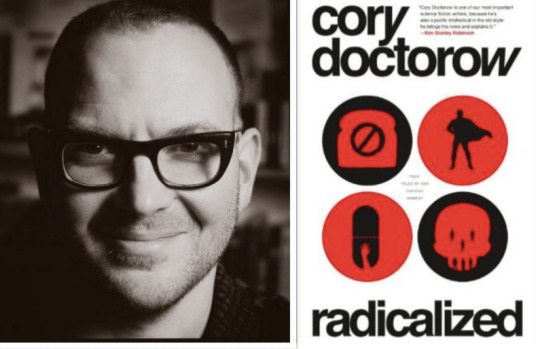
A few weeks ago, we reviewed Radicalized, a fantastic collection of four stories from author Cory Doctorow about the extreme measures that people (or a certain Kryptonian) will take to push back against extreme forms of oppression or circumstance.
Recently, I had the chance to speak with Mr. Doctorow about what inspired these tales as well as what some of the real world parallels they were inspired from.
There will also be spoilers for the various stories in Radicalized (especially Model Minority), so make sure you’ve already them first…which you really should have already.
AiPT!: Every story in Radicalized is great, but Model Minority really stood out to me, mostly because it was one of the best and most uniquely structured Superman stories I’ve ever read. What was your approach going into it to make Model Minority different than what has come before it?
Cory Doctorow: Humans have always been portrayed as his Achilles heel, but I think there’s an even deeper [issue] for Superman that goes back to his origins as a character. He was created by Jewish men in Brooklyn who were horrified about the rise of Nazism across the Atlantic. They wanted to build an immortal and unstoppable hero who could conceivably punch Nazis until they…well, stopped being Nazis!
But the actual answer to Nazis in Europe — although there were many brave individuals — was in no way an individual action. In fact, the answer was the largest collective action in the history of the world.
For reason both noble and base, I think we like to frame big fights as a struggle between individuals. The heroic individual who was at the right place at the right time and makes the sacrifice that makes things happen. Humanitarian movements definitely cultivate this.
Rosa Parks gets a lot of press as a solitary hero for her bus protest during the Civil Rights movement. But she was actually a community organizer who—along with her colleagues—planned out a strategy to get her arrested so that a case would be keyed up with a certain set of legal consequences that would be easier to argue in court and play into existing precedencies. If Rosa Parks had merely been a lone individual who was brave enough to refuse to give up her seat, she likely would have died in jail. It’s because she was part of a huge collective that she was able to have such a huge impact.
That’s what Model Minority really tries to dig into—the limits of individual action and the importance of collective action. Our perception of the individual as the driving force for change (rather than the collective) is something that still has a paralyzing effect on society’s willingness to confront its own issues. Look at climate change. It’s not happening because you didn’t recycle enough. But chances are (if you live in a city) that your biggest contribution to climate change is probably your commute. But you can’t dig a subway— Elon Musk can’t do that. And if even you could, you couldn’t rezone all the buildings for it to work. It would have to be a collective action.
AiPT!: Aside from Model Minority, the rest of the stories in Radicalized had a very near-future, Black Mirror-esque feel. Do you see the technology and events that took place as things we will see in the next few years?
Doctorow: I’m not a believer in the ability of science fiction to predict the future because I’m not a believer in predictable futures. That’s one of the big differences between an activist and a futurist. Activists believe that the future changes based on what we do. If the future were predictable, there’d be no reason to bring forth an event to create change.
The model of these stories is to show that the future can be great if we just don’t f*ck it up. The thing that drives a story like Unauthorized Bread is not merely that it shows how technological oppression takes place. It also shows how technical liberation takes place. People put a lot of emphasis on what technology does, but often overlook who it does those things for and who it does those things to. Often times that’s way more important.
Masque of Red Death was inspired in part by Doug Rushkoff’s story where he spoke to a bunch of hedge fund managers about their doomsday bunkers. They were trying to figure out how to make their bunkers sustainable after the apocalypse, but what worried them in particular was that their guards would kill them and take their food. One of the solutions they came up with were biometric food lockers that would only open for them. Once again, the issue isn’t what the technology does, but who has their finger on the button controlling it.
Going back to Model Minority, we have these predictive policing tools like the one Bruce sold to the NYPD. In reality, those tools are super racist. Patrick Ball, who runs the Human Rights Data Analysis Group, took PredPol (which is a major predictive policing tool) and gave it 2016 policing data from Oakland. He then asked it to provide where it predicted the most drug crime would be in 2017. He was then able to compare its predictions to the NIH survey about drug usage.
Predpol predicted that all of the drug crime was going to take place in black neighborhoods, which follows the police pattern that created its training data. If you’re only asking black people to turn out their pockets to look for drugs, then you all the drugs you find are going to be in black people’s pockets. According to the NIH data, however, illegal drug usage was pretty much even across the entire area among all demographics.
Now think about this: Instead of unfairly targeting a group of people, you could potentially use the exact same technology and data provided by PredPol (compared with the NIH data) to determine if policing patterns are racially biased. It’s all about whose finger is on the button.
AiPT!: Do you see the crisis on America’s southern border as a potential breaking point for people to become radicalized on both sides of the issue?
Doctorow: As a Canadian, I am somewhat baffled by both the American relationship to guns and the American relationship to healthcare. Every country has blind spots—when I lived in England, I couldn’t believe a country that managed to conquer the world still hadn’t figured out plumbing.
But America’s blind spots are pretty weird. The fact that they can’t do something every other country in the world has figured out is pretty baffling. It also spawns another weird question: Why is it that frustrated white dudes routinely shoot up mosques or kill their ex-wives, but don’t murder the healthcare executives who doom the people they love most in the world to die a slow, painful death? The pat answer would be that those executives are protected by a large amount of wealth and power. It’s much easier to punch down than punch up.
The other thing that Radicalized tries to do is to rebut our dominant model of radicalization, which is the contagion model. The idea with that model is there are a lot of people out there with very bad and dangerous ideas. If you get exposed to those ideas, then you will have the ideas too and go do bad and dangerous things.
But there’s not a lot of evidence to support that. Boston University did a study on the history of suicide bombers in the occupied territory in the West Bank. What they found was the biggest predictor of whether someone became radicalized was not ideology or a commitment to violence—it was if they were already suicidally depressed.
That trauma model—where people who are traumatized become much more susceptible/vulnerable to people with bad ideas—is a much truer account of what goes on in radicalization. It suggests that what we really need to be doing is reducing the amount of trauma as opposed to the exposure of people to bad ideas.
AiPT!: Where do you see that model at work in the current global landscape?
Doctorow: I feel like the people who are fighting it are being affected by racism that has been compounded by trauma. We’ve had 40 years of tightening belts and shifts in wealth from the middle to the wealthy. This has produced a large group of people who are traumatized and ready to be radicalized by difficult circumstances.
This about it this way: You think you have a secure chair at the table. Then someone announces “Actually, it’s not your chair. It’s musical chairs and at the end of the every turn, we’re going to decide whether or not you get one. Oh, and by the way, we’re going to let a bunch of people who have never had a chair compete for the chairs, as well…and we’re going to take away chairs at a faster than any in point in human history.”
When you consider that framework, it’s not a surprise that people can become racist, xenophobic a------s. It doesn’t exonerate or excuse them, obviously, but it does help explain it.
The arguments anti-vaxxers make today aren’t any better or more informed than they used to be. It was a stupid argument then and it’s a stupid argument now. Same with flat eartherism. What changes are the material circumstances of the people who believe the arguments. When you look at the rise of authoritarian movements throughout history, they almost always follow some sort of collective trauma.
Another source of trauma for people is that despite the wealth of information at our fingertips, there is a collective inability to trust it. There so many different sources of information that it becomes impossible to adjudicate them all, which forces you to defer to whomever is deemed the expert…or whoever shouts their information the loudest. That’s part of the reason you can have the FDA saying for 15 years that opioids were safe. Even the government can’t be trusted as a source. This leads to people often times finding someone who “feels” like someone they can trust whether they are credible or not—and you just believe whatever they tell you.
AiPT!: Moving onto something a little more light-hearted: Is Superman (or any other character in the DC Universe) someone you’d like to revisit in the future?
Doctorow: Honestly, I didn’t really always want to write Superman. In this instance, Superman was simply the right metaphor for the bigger question about individual and collective action and being an ally.
Speaking as someone whose father was a Jewish immigrant refugee to Canada, it was odd to see how he was initially treated as a racialized minority, but later “became” white. It showed me how whiteness is socially constructed—and how the last people on the whiteness boat are usually the first ones to get kicked off. In Charlotte, we had people chanting “Jews will not replace us,” but there are still conservative Jews (including within my own family) who treat white supremacy as a small price to pay as support for Israel and other portions of the GOP agenda.
One thing I wanted to draw attention to in Model Minority is that Superman’s whiteness (and humanity) is assigned to him as a courtesy. It is entirely contingent on his support of the establishment, who can withdraw it at a moment’s notice. It also shows the difficulty of allyship. No matter what you go through to help others, your struggle will pale in comparison to the ones without your privilege who you’re trying to help. Just like when Superman was asked “Where were you for the last 100 years,” you might have to confront the fact that you were previously a part of the problem.
That’s not to say we need to play oppression Olympics with everyone to compete for who has struggled the most in society. But I do think we need to acknowledge that the daily experience of different people in different experiences is something that we can’t fully comprehend.
AiPT!: This probably won’t be possible with Model Minority due to all the licensing red tape you’d have to jump through, but are there plans to make any of the other stories in Radicalized into other media properties?
Doctorow: Unauthorized Bread is currently in development as a television project. That’s all I can say for now
www.adventuresinpoortaste.com/2019/08/13/collective-action-an-interview-with-cory-doctorow-author-of-radicalized/
24 notes
·
View notes
Text
That Was So Real: Jeff Buckley's Collaborators Tell The Story Behind 'Grace'
8/23/2019 by Steven Edelstone
Celebrating its 25th anniversary, the album is being reissued today alongside the release of four full live sets.
“Hey remember that riff you played me at your parents’ place when we were playing guitar on your bed?”
It was April 1994 and singer-songwriter Jeff Buckley’s classic debut album, Grace -- which turns 25 today (Aug. 23), and is being celebrated with a major reissue via Columbia/Legacy Recordings -- was essentially done, set to come out in just a few months. Buckley, then 27, had recently enlisted his friend Michael Tighe, just 19 at the time, to play guitar in his live band as he was gearing up for what would become a grueling, almost two-year world tour.
He convened the rest of his band, made up of bassist Mick Grøndahl and drummer Matt Johnson, to record some B-sides at Sony Studios in Midtown, Manhattan. It was Tighe’s first rehearsal and it began with Buckley asking him to play a guitar riff he showed him at his parents’ place in the West Village about a year and a half prior.
The song quickly became “So Real,” a track that would eventually be situated at the heart of Grace, a stunning alt-rock track that would break up the hushed fingerpicked guitars of “Lilac Wine” and “Hallelujah" -- the latter of which has remained in the public memory long after his death, and still serves as the introduction to his back catalogue to many.
“I played it, and he got behind the drums and started singing the melody to the chorus, and we kind of knew it was something special,” Tighe remembers. “We did the instrumental and that night, he just took a long walk around Hell’s Kitchen and came back and had the lyrics and the melody for the verses and he laid it all down in like two takes. Afterwards, he was like, ‘I want this song to go on the album.’”
“When Jeff took what he did and put his vocals on it and his lyrics, I couldn’t believe it,” Johnson adds. “I thought it was unbelievable. I was like, ‘Oh my god, this guy is amazing!’ I loved what he did, and I was so impressed with the way his melody was so unimaginable, given the instrumental track. In a million years I never would have thought about that.”
But there was one issue: Buckley wanted to add “So Real” to the tracklist in the place of “Forget Her,” a sorrowful and dark, yet direct song that higher ups at the label, including producer Andy Wallace, wanted as the lead single. Buckley now wanted it to remain unreleased entirely.
“It’s the one thing with the album that I wasn’t happy with, that “Forget Her” was left off -- because it was absolutely intended to be part of the album,” Wallace explains, noting that the song was 100% done at the time. “I remember we took him out to dinner, Don [Ienner, Chairman of Sony Music Label Group], Steve [Berkowitz, A&R executive at Columbia who signed Buckley], and me. If I recall correctly, the main point of that dinner was, ‘Reconsider Jeff, blah blah blah.’ He was adamant, and God bless him, he stuck to his guts.”
Read More
Jeff Buckley's Manager On Why He Waited 21 Years To Release Memoir: 'It's Raw To This Day'
For as great as the ultra-personal “Forget Her” was -- the song was eventually given a legitimate release years after Buckley’s tragic 1997 death on the Grace (Legacy Edition) compilation in 2004 -- it wasn’t necessary to launch the New York-based singer from legendary local live act to a worldwide cult phenomenon. Though the album was dogged by slow sales Stateside, eventually peaking at No. 149 on the Billboard 200 albums chart almost a year after its release (he was initially much more successful in Europe and especially in Australia), it was eventually certified Platinum by the RIAA in 2016, 22 years after it hit record stores.
Now, 25 years after its release, the album is being reissued by Columbia/Legacy Recordings, complete with the release of four full live sets: Live at Wetlands, New York, NY 8/16/94; Live From Seattle, WA, May 7, 1995; Cabaret Metro, Chicago, IL, May 13, 1995; and Live at Columbia Records Radio Hour.
But what became Grace was almost a radically different sounding album. Signed on the strength of his renowned residency at the now-closed East Village venue Sin-é, which saw Buckley perform a wide array of covers and original material each Monday night beginning in April 1992, Columbia initially mulled the idea of a debut release that would have reflected the sparse, solo-electric spirit of the shows, which were marked by his sense of humor and incredible crowdwork (check out his mini cover of Pakistani legend Nusrat Fateh Ali Khan, sung over the “Smells Like Teen Spirit” riff). Though some songs in that vein would make the eventual album -- his covers of “Hallelujah” and “Lilac Wine,” originally by Leonard Cohen and James Shelton (and made popular by Nina Simone and Eartha Kitt), respectively, were the most prominent examples -- Buckley, as well as Wallace and Berkowitz, decided to go in a different direction.
“He wanted to do a band album; he didn’t want to do a solo thing,” Wallace says, who has since worked with Coldplay, Paul McCartney, and The Strokes, amongst dozens of other high profile bands. “There was some talk about that, whether it was best to do something that reflected what he was doing at Sin-é, because he was so good at it. It’s hard to do a full album of just the solo thing, especially because so much of his magic had to do with his persona and his live interaction with the audience. That’s virtually impossible to capture on a record, at least with the same impact.”
The label agreed on the condition that they would put out an EP recording of one of the Sin-é gigs, which was later stretched out into a full LP in 2003. Released in late 1993, it included two originals, as well as stunning renditions of Van Morrison’s “The Way Young Lovers Do” and his take on an old French song, “Je n’en connais pas la fin.” This served as a way to introduce Buckley to an audience outside of Lower Manhattan, hint that more music was on the way, and allow him to pursue forming a real band.
“He just always wanted to be in a band, that was his dream,” Tighe says, who has since written songs alongside Andrew Wyatt for Liam Gallagher, and worked with Adele. “He idolized Led Zeppelin and the chemistry that bands have -- to a degree, the family unit that a band has. I think he really wanted that for a long time.”
Though he now had a trio, made up of Grøndahl, Johnson, and himself, to record with -- Tighe wasn’t added until the recording sessions were largely completed -- Wallace still wanted Buckley to record a bevy of paired-down solo versions of all of the songs. Most nights while recording in Bearsville, New York, a small town in the Catskills, Wallace would have him go out to the live room after dinner -- maybe with a glass of wine -- and perform his Sin-é gig without stopping.
Read More
Live Jeff Buckley Recordings Will Soon Be Available for Streaming
It was in this setting that Buckley was most relaxed (“He definitely seemed like he was most comfortable when he was playing live in general,” Tighe believes), and it allowed him to unwind a bit, while still recording. This is one of the main reasons why so much solo material has been released since his death on various legacy albums and compilations: There’s a still-unreleased version of “Hallelujah” with an extended minor key intro floating around somewhere, Wallace says.
While a lot of the song arrangements were hammered out in pre-production rehearsals, this was an incredibly new band, very much still feeling each other out. Some of these songs were born in the recording studio, including “Dream Brother” -- which, like “So Real,” was marked by the instrumental track being recorded before Buckley had even written the lyrics or melody.
“My musicianship I wouldn’t say was great at the time, but I did feel like I was resonant with Jeff emotionally -- and just in terms of the raw quality of listening to music as music,” Johnson remembers, now the drummer for St. Vincent since 2011. “The depth of his listening showed me how to play music in many ways. The sensitivity to his voice… It was kind of scary sometimes. I felt like a bull in a china shop. I felt like I wasn’t good enough to be in his band. It was formative, and it made me who I am.”
Song after song was then cranked out in that big, ambient room in Upstate New York. From the wild quiet-loud dynamics of “Mojo Pin” to the magical Kerl Berger-arranged strings on “Last Goodbye,” it was obvious that they were working on something extraordinary.
“There’s never a turning point where a light goes on, and you’re like, ‘Oh my god, this is an incredible album!’” Wallace says. “But I can remember the first time that I really went, ‘Wow, this is not just a young guy with a great voice and a great ability to entertain an audience. It was probably the first time I went to see him at Sin-é and he played ‘Grace,’ which I had never heard before... I remember very specifically, looking over at [Buckley’s manager] George [Stein], ‘Where did that song come from? I’ve never heard that!’ And he said, ‘Oh that’s one of Jeff’s originals.’ That was the first time I felt, ‘Wow, there’s something really special going on.’”
The album would take Buckley and his band around the world multiple times over, even returning to play the same metro areas multiple times in the same year to develop his fanbase, with a heavy investment by Columbia. Always the consummate live performer, Buckley would sometimes leave his own bandmates stunned.
“There would be some nights where he would do some things with his voice where it would completely blow me away,” Tighe remembers. “The thing about performing with him is that he managed to cast a spell over the audience and because of that voice he had, he did the same with the band members. It was like we were in a bit of a trance most of the time. He really had that kind of power to his voice.”
If anything, those around him remember Buckley most for his passion and his sense of humor. Whether it was seeing him light up when meeting his hero, Jimmy Page, after a show at a beautiful theatre in Melbourne or just joking around in the tour van, he had a sensitive and magnetic personality that lives on in everyone that knew him personally.
“There’s a line in one of his songs on [the posthumous release, Sketches for] My Sweetheart the Drunk, ‘I miss my beautiful friend,’” Wallace says, tearing up over the phone as he recites the lyric from “Morning Theft.” “Every time I think of that, I miss my beautiful friend. And I’ve never stopped missing him.”
#Jeff Buckley#That Was So Real: Jeff Buckley's Collaborators Tell The Story Behind 'Grace'#the story behind grace#release of four full live sets#Grace reissued#Grace 25th anniversary
9 notes
·
View notes
Text
thoughts on rereading 1632 & 1633
i read these books by Eric Flint a few years back, got to some later ones, and lost track of where i’d been. So, i got the audiobooks via one of the ebook services from the library, and started going through them again. I had a few thoughts on this read-through.
for those who are unfamiliar with them, the central idea is that a cosmic accident (caused by alien artists messing with space-time, but the human characters never learn this and give up pretty quickly on ever figuring it out) has taken the entirety of a West Virginia mining town from April of 1999 and swapped it with an equally-sized region of central Germany (specifically, Thuringia) in the year 1632. The introduction of modern American technologies and values into the middle of the damned Thirty Years War causes massive social and historic changes, of course.
the negative points are going to be obvious to most Tumblr users even without me going into detail about the plot and characters. There’s a lot in the way of American patriotism, for a starter, and i’m sure a European reader would shrink at the idea of turn-of-the-millennium American values being imposed on any part of Europe, much less its historic past. The character who quickly rises to become the political leader of the time-displaced Americans is very determined to spread those values. Additionally, there’s a lot of the usual problems of sci-fi/fantasy as far as the portrayal of women, particularly in terms of women in wartime. The subject of sexual assault comes up often, and from my perspective, the text of the first novel focuses too much of the time spent from women’s perspective on exploring how they feel about men. While it serves to establish that the relationship is consensual and based in mutual respect, a scene involving the wedding night of two newly married characters goes on for far too long and into far more detail than is necessary. While a couple 17th-century women are prominent in the first book, the American women who play any significant role are treated as exceptional—a schoolteacher with New England origins and a politically radical background, and a teenage girl noted for her athleticism and [spoiler]. A singular Asian character basically only exists so that her American husband can prove a point about how shitty it is to discriminate, and i don’t recall that she even actually has any speaking lines until the second book, much less even actually appearing on the page.
on the positive side, one of the most prominent characters is not only a Jewish woman, but specifically a Sephardic woman, and she is upheld consistently as the equal of any of the American characters, if not better than most. It’s noted that the Americans are sorely lacking in many skills that the 17th century Europeans consider mundane, such as speaking any more than a single language. The spread of American values and technology is consciously and openly done in order to try to reduce deaths from disease, poverty, and starvation, as well as bringing about democracy at a time when the power of the aristocracy was absolute. The Americans are consistently shown to be absolutely disgusted by the idea of rape, arguably above anything else they find unpleasant about the time period. 17th-century characters are treated as real humans with their own skills and knowledge that often beats out the technological advancement of the Americans.
having read a lot of trashy isekai manga since reading this the first time, the comparison to other “modern character in less-advanced world” scenarios seems obvious. The Americans are acknowledged to have their faults, misconceptions, and flaws. The author has a stated dislike of the “great man” concept where singular powerful figures make all the advancements; even with people like Gustavus Adolphus being prominent, The American characters we see have a firm distaste for racism, antisemitism, and other forms of bigotry; one of the most prominent characters is a visiting black doctor, and his daughter becomes significant in later books. It is not denied that racism exists, and even some of the POV characters are shown needing to unlearn bigoted ideas. Labor rights are a major theme in the books; the author has a union background and so do most of the American characters. There is a deliberate effort on the part of the American characters to avoid a scenario where "up-timers” become a new aristocracy.
one thought kept occurring to me while going through these books again: this seems very much like a series that could be adapted for premium TV. You wouldn’t even need to budget special effects, and i’m sure there are plenty of existing costumes. There’s an abundance of sequels and side-stories, and still more every year. And plenty of the things i consider flaws of the books are things that would get American audiences into it on the small screen.
12 notes
·
View notes
Text
under a cut because long, disorganized, self-indulgent
ok so the Lende Empire isn’t really feudal; I despise feudal stasis in fantasy, like even the shortest timeline puts the Andal invasion at more than 2,000 ybp in Game of Thrones, you really think in all that time everybody on the continent is dumb enough to not invent a better plough? or glass just good enough to grind lenses? or make small improvements in windmill design? and all that shit adds up and BAM before you know it, you've got metallurgy good enough to make a steam engine with, so no matter what BS magical physics you come up with, if things work at the human scale even remotely like they do in our world, your age of knights and castles and dragons not having to contend with antiaircraft guns has a limited shelf-life.
(and that's interesting! And more people--by which i mean people besides Terry Pratchett, who did this wonderfully--should write about high fantasy worlds before they reached Medieval Stasis Mode, and after they left it! I would fukkin kill to read a good high fantasy book that also had, like spaceships in it. Insofar as genre conventions have evolved not according to the internal logic of the worlds they depict but according to how and for what reason they serve as commentaries on specific aspects of our own world and its history, and are aimed at evoking certain emotions, it's understandable why such generic mishsmashes are relatively uncommon. But people also definitely read speculative fiction because they like internally cohesive worlds very different from our own, so it is my fondest hope that this sort of thing becomes more popular going forward)
(you can of course also have fantasy worlds which are *not* very much like our own world at human scale. Greg Egan actually does this in a science fiction mode, but as long as you're positing a world where dimensions of space are hyperbolic like time or where humans change sex every time they have sex because trading a detachable symbiotic penis is part of having an orgasm, whether you call this stuff "different science" or "magic" is really beside the point. I have an idea I've been batting around for a while about a world divided, like Evan Dahm's Overside, or the two parallel worlds in Fringe, except part of the division is not just physical, but metaphysical. Morality itself in each subworld is defective, because each subworld got a different part of a morally and metaphysically unified whole: thus, for reasons nobody can understand, almost every ethical system derived by people resident in only one subworld is deeply defective, and would be horrifying to us--as though, perhaps, our own complex and nuanced moral landscape that we wrestle with was a kind of grand unified theory whose symmetry had been broken, and which was only understood piecemeal, as totally separate concepts. And of course, if you live in one subworld everyone from the other subworld is a horrifying monster whose morality is totally incomprehensible to you, so you reflexively treat them as an enemy.)
History isn't just one thing after another. I mean, okay, it is, but it's *also* the aftereffects of those things, the things that stick around forever and can't be gotten away from. And just like how if you want to understand our own world you need to look at what it was like five years ago, and to understand what it was like five years ago you need to look at what it was like ten years ago, and fifteen, ad nauseam, until you're suddenly back at World War II, or the Holy Roman Empire, or Sumer, or struggling through the ever-increasing fog of a steadily more ambiguous archeological record, well, this is as true for politics and language as it is the material aspects of society. In the same way maps feel insufficient when the artist doesn't think about what's beyond the edge of the page (not to knock on GRRM too much, but if you put all the continents and seas in his world on the same map, you notice they're all really... rectangular. Like he drew them to fit individual pieces of paper. Rivers and island arcs get compressed when they near a margin. Seas are just voids. Nothing ever has to be moved to a little box in a corner to fit. there's no attempt at verisimilitude), I think invented worlds feel insufficient when the writer asks you to take them seriously as a reflection of our own, or an aspect of our own, but neglects to at least suggest their place in a larger whole.
I wanted with the Lende Empire to have something that still let me have a lot of early centuries of sword-and-horse style adventures (because i started writing about Lende when I was thirteen and had just finished the Silmarillion for the second time), and I wanted when writing its history to still be able to take big chunks of story I stole from Norse legends and medieval poetry and dump them almost whole into the setting, but I also wanted the history not to read like a fantasy history--or not just a fantasy history. What I mean is, when you read something like the Silmarillion, or when a character in a fantasy world relates some legend to you, even if it's referred to as an old and ambiguous tale, you still often feel like that's really what happened. Like, for me, one of the chief emotional attractions to something like the tales of the wars of the Goths and Huns, or Beowulf's description of Migration Age Denmark filtered through Anglo-Saxon poetic tropes, or the Icelandic family sagas, is that we really have a hard time knowing how much of it is true, how much of its is plausible embellishment, and how much of it is anachronistic nonsense or pure bullshit. Is the Njala based on a faithfully recounted tradition passed down orally for a few hundred years? Who knows! Not us. We know a guy named Njal got burned in his house around 1000 AD, but much of the mystery and the poignancy of stories like that for me lies in the difficulty of ascertaining their relationship to the truth.
What I want(ed) was something that when you read it made you think "ok, obviously the narrator is trying their best, but even they don't know exactly what the fuck happened; this is probably one third ambiguous tradition, one third solid, one third bullshit." So the Chronicle of Lende has some stuff in it that's intentionally difficult to reconcile. It has weird tonal shifts. The first third owes a lot to the Anglo-Saxon Chronicle and the sagas and the Hildebrantslied; the middle is closer to the Silmarillion, or the history of Rome when told more from the Great Man perspective than the Impersonal Forces one, and the last third starts out that way but goes some weird places and veers off at the end to what is obviously a symbolic and highly abstracted mode of narration which, in relating the destruction of the Empire imitates the way in which its beginning is related (for in-universe Thematic Reasons), *but* while all this is going on, the hope is that the reader is *also* able to glimpse through these ambiguities and stylistic quirks, and incompatibilities, and weird digressions involving talking animals or the spirit world, a society that's undergoing familiar demographic and social and technological transitions: moving from oral culture agrarianism to the beginnings of a real urban civilization, with a centralized state and the written word, and like Western Europe having to figure out a social structure in the absence of any good nearby imperial models (they end up with something more like fraternal warrior societies being deputized to control land rather than feudal lords, but the essential logic is the same); but then moving to a real model of administrative statehood, as infrastructure and technology improve, before industrialization kicks off, the population explodes, social tensions inherent in that begin tearing at the seams of society, and the horrors of industrialized warfare are unleashed.
There are meant to be striking differences, too, of course. Lende history is only about a thousand Earth years long, and it's confined mostly to the western side of a continent split by a huge, Himalayan-like mountain range. Its rapid rise and increase in technological sophistication are due to exogenous factors (genuine divine intervention in some cases), and equally even the True Secret History of the empire's destruction has no real-world parallels, at least not since the Channeled Scablands formed 14,000 years ago. It's also teeeechnically science fiction and not fantasy, though that distinction really rests on tone and not on setting IMO. But I don't think it's possible to tell what feels like a real history of a world without sometimes radically changing genres: our own history goes from dry science (geology, paleontology, archeology) to legend and myth and scripture, to dusty old classical history and books penned by ancients who sometimes have startlingly different notions about what merits mention in a story and how to tell one, to tales of kings and queens and conquerors, before emerging blinking in the sunlight of dry matter of fact narration again. I have always believed conventions, including those of genre and style, should be tools and not straightjackets. The best worldbuilding literature I have read steals from a huge variety of sources (and Pratchett deserves a mention here again, alongside Susanna Clarke, and Ada Palmer, and the people who wrote the Elder Scrolls backstory, and Sofia Samatar, and Angelica Gorodischer).
#have you read a stranger in olondria?#go read a stranger in olondria#now#fucking do it#it's so good#'a book' says Vandos of Ur-Amakir 'is a fortress; a place of weeping; the key to a desert; a river that has no bridge; a garden of spears.'
13 notes
·
View notes
Text
Shoebox Project Day 2
I was going to write about Lupin — about how well he’s written here and how much his character resonated with me (more than I’ve resonated with a fictional character in forever). But then I got curious and read the end of the Shoebox Project. So now I have to talk about Peter Pettigrew.
Just by way of contrast, let’s look at how Fantastic Beasts handled the subject of radicalization and the spread of fascism and regressive politics. In part 1 of the series, we are introduced to feminist flapper mind-reader Queenie. She’s a hyper feminine love interest for the Muggle character, but she also has a sense of agency and independence about her, and a depth to her personality that makes her somewhat nuanced.
So of course part 2 totally ruined that. Now, Queenie is entirely defined by her relationship with literal random Muggle Jacob Kowalski, to the point of drugging him with a love potion so that he’ll agree to fly to Europe and get married. What an impressive non sequiter! It totally flattens her character because her entire arc in the movie revolves around “I want to marry this muggle dude.” That’s bad enough, but on top of it her arc is stupid. First, she gets lost in the rain and is confused and sad. Then, Johnny “I need to get a Spray Tan” Depp shows up and is like “hey, sorry you had a bad day, and not being able to love who you love sucks (ignore the queer baiting hehe). Do you wanna come to my Neo-Nazi rally?” THEN SHE SAYS YES, and literally brings her Muggle boyfriend to the Neo-Nazi rally. That’s like someone in the 1950s taking their black boyfriend to a KKK rally. It makes no sense. Anyway, Jacob “Analysis Penguin” Kowalski realizes this is really bad and dangerous for him, so he’s like “hey we should dip,” and she’s like “I love you babe but I think Imma hang out with Hot Topic Hitler for a little bit he seems chill as fuck” and JOINS Grindelwald, leaving her Muggle boyfriend behind (despite this being her original motivation to listen to Grindelwald???).
This is literally incoherent as a character narrative, but it’s used to basically say two things. One, we shouldn’t punch Nazi’s or break up their rally’s because they’ll use violence as a recruiting tool. Which like, is a good point I guess, but why is that the thesis of your movie about facism in 2018? But the other point, more importantly, is two: that it’s feminist women who are defecting to the alt-right and causing all the problems.
Of course there are alt-right women, some of whom used to identify as much further left (or at least, there’s one — Laci Green — and maybe that’s it?). But it’s men, in particular young men, who are joining fringe alt-right groups in droves and fueling their activity. That doesn’t invalidate Queenie’s arc in Fantastic Beasts but the movie is pretty clearing making a statement about modern politics (Grindelwald’s rallies are just goth trump rallies). So Queenie’s arc is supposed to be making some kind of point about modern politics but it just sort of fails at doing that. It doesn’t engage with the societal trends that are actually affecting the political landscape, which leaves whatever point was being made about facism hollow.
The Shoebox Project does not do any of that.
Peter Pettigrew’s fall from grace in the last entry of the Shoebox project is gripping, horrifying, and emotionally realistic. The audience is confronted with the paucity of Peter’s life in direct contrast to the happiness James, Lily, Lupin, and Sirius are experiencing. Peter has nothing, basically is nothing, and is rejected as an inconvenience by friends that have completely moved on from him. Peter suffers a crisis of identity — he doesn’t have passions, or preferences, or opinions, or any sort of personality. He’s just sort of alive and there, and in this final chapter he becomes aware of his own lack of identity. After trying to reach out, and failing, someone reaches out to him — a complete reversal of what Peter’s used to. He’s given time and space to express his feelings, and made to feel seen and (at least in some sense) valuable. Then, when the discussion turns political, Peter goes along with his companion’s blood supremacy becomes it is slowly revealed in pieces, and because at every step Peter just wants approval and to pay back the kindness he’s received. Peter just wants to follow, to be part of something, and to be given an identity rather than constructing his own. This means that, in a moment of crisis, he becomes willing to latch on to whatever identity is in the vicinity. It’s telling that Peter doesn’t really think about the implications of engaging in this blood supremacy until he’s already mostly sucked into it — and even then it’s halfhearted. Because as much as scapegoat theory is talked about, and is valid, in my experience (at least in today’s world) its much more about identity. The scapegoat tendency comes after the identity is in place, and while it’s convenient and comforting for those people, it isn’t the impetus. It’s the feeling of being part of something, being handed an identity, a set of slogans that, if repeated blindly, will turn you into a real person, that drives recruitment numbers.
[Side note: It’s interesting that Pettigrew here is sort of the inverted double of Snape. Pettigrew hates Lily, because she represents the end of childhood and the forces that have pushed Peter out of the Marauders. It’s this hatred, despite his admiration for James, that leads Pettigrew down a dark path. This is a really cool parallel, and it makes sense how Peter’s identity issues could lead to radicalization — his anger simply has to be focused on Lily’s blood status specifically.]
This is a real story about how radicalization really happens, and about how people are lead down dark paths in general. It’s a coherent arc for Peter, makes sense with his character, and reflects broader societal trends. Basically this is really good socially aware fiction writing. It’s really too bad that this isn’t the social commentary set in the Harry Potter universe most people are getting right now.
2 notes
·
View notes
Note
please tell us more about the subversiveness of dante!!
so there are…a lot of aspects of the divine comedy that are intensely transgressive— from the explicit condemnation of the papacy, to the inclusion of virtuous pagans in limbo that flew in the face of all established theology, to the by-name callouts of sometimes-still-living individual public figures as present in hell. and that’s not even counting the poetry, or de monarchia, which is a whole other post on its own.
i mean, the political aspect of it is one thing. in dante’s time, europe was essentially split into guelfs, who supported the right of the papacy to act as a political power; and ghibellines, who thought that the papacy ought to limit itself to just the religious sphere, and the holy roman empire ought to do all the politicking. ideally, that is. oftentimes ghibellines were leaders of independent city-states who just wanted the papacy to stop sticking its nose where it wasn’t wanted. but the thing is that by the time dante came of political age, in the 1290s, the golden age of ghibellinism had come and gone with the failure of frederick ii to consolidate an empire in italy— before dante was even born, every single ghibelline had been violently driven out of florence. for him to express the explicitly ghibelline views he does in the divine comedy, then, is an incredibly radical thing; had he not already been exiled, that would probably have done the trick. ghibellines in the political sphere were simply not tolerated, especially after the ascension of boniface viii— one of the most politically-involved popes of the middle ages, and in many ways the forerunner of alexander vi— to the throne.
besides all that, dante was fiercely opposed to political corruption and barratry in a way that most people just weren’t, because such practice was considered typical, even necessary. think gilded-age america, and the massive political machines that ensured that the government ran smoothly (if unfairly). this makes a lot of sense when you remember that when dante was exiled in 1302, the offense he was charged with was taking bribes during his time as prior back in 1300— something he emphatically did not do, but was punished for anyway. therefore, he has zero tolerance for corrupt officials, and that sentiment extends toward a relatively new practice at the papal court: the indulgences boniface initiated for the first-ever papal jubilee, in 1300.
which brings me to my next point: dante hated the papacy, and especially popes boniface viii and clement v. he thought the papacy was an agent of corruption in politics and in the life of the spirit, and (as you might imagine) was in no way convinced of the pope as the mouthpiece of god on earth. we actually see multiple popes in hell! in heaven, st peter himself rails against the debasement of his office! the extent to which dante not only wanted the papacy out of politics, but actively despised what it had become, cannot be overstated. and in a guelf world, a world in which the papacy was one of the most important political powers in europe and would continue to be so for the next 250 years, that was not a very popular opinion. people call dante the medieval luther for his attitude towards the papacy, and towards papal corruption— and while i can see where they’re coming from, the key difference is that dante was a radical in service of the church, because he understood that christianity is not theology alone but community as well, whereas martin luther was a radical in separation from the church. (fuck martin luther, is what i’m saying.)
all that aside! i could also talk about the ways in which dante is theologically subversive, the ways in which his cosmology is at odds w/ a thomistic perception of the world, but i don’t know anything about theology, so what i AM going to talk about is the sexual aspect. this goes back to the whole courtly love schema, which is: lover is in love with his lady, but in an idealized, un-physical manner, and his devotion requires nothing from her. she doesn’t even have to notice him. that’s the tradition that informs the way dante writes about beatrice, but when he does it, it’s…different, in several important ways. one is that dante is also informed by the poetry of his best friend/poetic mentor/possible (probable) boyfriend guido cavalcanti, who wrote that love is a sickness, an affliction that ought to be avoided so that you can live a good life. for dante, love— his love for beatrice, at least— is absolutely an affliction, in the cavalcantian sense. in his first book, la vita nuova, he chronicles the story of their, uh, “romance,” which mostly consists of him being in awe of her and her occasionally noticing him, until she dies and he resolves not to write any more poetry about her until he’s skilled enough to do her justice. but whenever she gets close to him— whenever she touches him, smiles at him, even just looks at him— he completely loses the ability to be a person. he gets faint, turns pale, can’t even speak; i think he even swoons once or twice. the thing is, though, that that love-sickness, that pain, isn’t a bug, as guido would say, but a feature— for dante, being hurt is a part of being in real, transcendent, spiritual love.
now, that’s not something new— it’s a very catullan, very classical elegist sentiment— but it becomes pretty darn transgressive when you couple it with the other way in which dante subverts the classic courtly love schema. in that, the lady is almost always silent, disengaged— i wouldn’t go so far as to say objectified, but she isn’t a part of the emotional life of the poetry. she doesn’t engage with the lover, or if she does, it’s brief and perfunctory. that’s somewhat like the beatrice we see in la vita nuova— as much power as she has over dante, as easily as she can make faint and dizzy with emotion, she doesn’t really talk. she isn’t participant. she doesn’t care what she is to him. in the divine comedy, though, that all changes— from the minute beatrice shows up, in the last canto of purgatorio, she’s extremely vocal. she spends most of that canto yelling at dante for letting himself get lost in that metaphorical dark wood of inferno i; for letting himself stray from her, and (by implication, because the whole thing is that beatrice is the personal embodiment of the divine) from god. and when she’s done with him, when he’s on his knees in front of her, he tries to answer her, and finds that he’s physically lost the capacity for speech. he’s been reduced to total silence. and this is so much not just because it very clearly subverts the normal courtly love formulation of vocal lover/silent lady, but also because his voice, his words are what make dante important, in the grand scheme of things. he’s a poet— he proclaims himself one of the six best poets of all time— without that, he is absolutely insignificant. that’s what beatrice makes him, when she takes his voice away.
that dichotomy continues, even into the rest of the poem. most of paradiso, all the knotty theological explanation is done by beatrice, rather than dante having some male saint relate it. she talks, teaches him; he listens, learns, is enlightened, because she’s divine and he isn’t. there are a couple of times when he asks her to tell her something, and she says: i can’t do that, because you’re human, and fragile, and i don’t want to break you. the point is, though: she knows and he doesn’t, she speaks and he’s silent, she can make him faint with just a glance. she has power over him in every possible way, which is partly an extension, but mostly a subversion, of the courtly love schema. and when you take that and you add in the theological explanation, the fact that beatrice is the one who imparts to dante the truths of the universe— it’s a kind of mixing of sex and scholasticism that you just. didn’t do. not even if you were heloise and abelard. he’s helpless to her in every way imaginable, and their power differential is framed with theology. it’s so much, y’all.
295 notes
·
View notes
Text
The September Vogue Mood Report
Don’t shoot the messenger.
For the second year in a row, Vogue has turned political and I must discuss it in order to do an accurate mood report. I dislike politics and rarely discuss the subject, so for the second year this was not a fun report to write.
I was so saddened by last year’s issue that I barely spent any time on it, focusing mainly on the cover which I labeled “Sunset Of Liberty.”
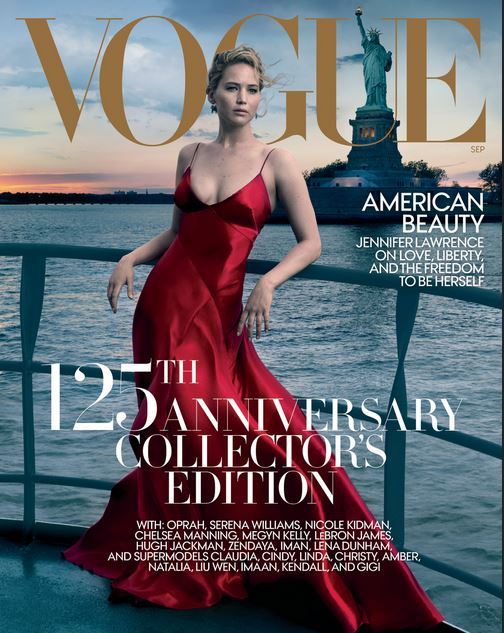
If it’s true that “Democracy Dies In Darkness,” I very much wanted to be wrong, but it does not appear so. Not with the emergence of Shadow Banning and Search Engine Manipulation against political opponents, or land confiscation in South Africa based on skin color (which, like Europe’s Migrant Rape Crisis, is deemed racist to even discuss).
Shadow Banning and Search Engine Manipulation is repugnant to a free society. It is otherwise known as censorship.
This year I’ve left emotions at the door and have instead followed the rabbit hole. My job is not to judge. My job is to analyze content through the lens of social mood . . . while it’s still permissible to do so.
On second look, it turns out that there was a familiar political theme in 2017 that morphed into this year’s edition.
This year seemed to be a consistent strategy of repetitive political talking points.
This is important to be aware of because whether it’s propaganda, advertising, or politics, the strategy is always the same: repetition.
Messaging and persuasion is achieved through repetition.
Keep repeating it and it sticks.
Get it?
It’s an insidious process if you’re not paying attention. It’s happened to me. During my tenure at Condé Nast reading over two dozen magazines cover-to-cover each month because my job required it, my sensibilities were drastically altered. I didn’t notice it until I left the city and my new attitudes were wildly apocryphal, quite incompatible with real life. It was bizarre how subtly it occurred.
“I love journalism. My dad was an editor, my brother is a political editor, it is just a world that I am steeped in.“
~ Anna Wintour
It is not a conspiracy theory to illustrate Anna Wintour’s connection to politics.
In 2008 she was appointed to the Order of the British Empire.
In October 2009, President Obama appointed her to the President’s Committee on the Arts and Humanities.
In 2011 she was awarded the Legion d’Honneur by French President Nicolas Sarkozy.
In 2013 she was named Artistic Director of Condé Nast.
In October 2016, Vogue made its first political endorsement in its 124-year-history, calling Hillary Clinton “optimistic, forward-looking, and modern.” (Remember that word “forward.”)
In 2017, for her service to British journalism and fashion, she was named Dame Commander (DBE) of the Order of the British Empire by Queen Elizabeth II.
With her new role as Artistic Director, Dame Anna Wintour now controls the editorial vision not only for Vogue, but every title published by its parent company, Condé Nast.

Wintour is therefore at the nucleus of powerful ecosystem that intersects with a vast array of companies and, according to The Business Of Fashion, operates as an “unofficial, behind-the-scenes consultant to CEOs, designers, politicians and movie stars in America and beyond.”
“Wintour is indeed more like a head of state than a mere editor-in-chief, a position which gives her a unique, bird’s-eye view of the fashion industry, emanating outwards from Vogue and Condé Nast to the wider ecosystem that sustains this $2.4 trillion industry.”
~ The Business Of Fashion
In short, she is in a position to sway millions of opinions and trillions of dollars. And with a keen eye for politics and a nose for power, she’s taking advantage of it.
“One of the initiatives I have here in my role as artistic director is that I have regular Editorial Task Force meetings, or ETFs, where we invite leaders from other worlds to come in and talk to the editors-in-chief and the digital leaders and a few other people about what they see happening in their industries, whether it be media or Silicon Valley — we pull them from everywhere.”
~ Anna Wintour
Yet even if there was a deliberate political messaging strategy at work in this year’s September Vogue, the message itself is largely irrelevant for this analysis.
Yes, irrelevant.
Instead, the task for Mood Report is to answer the larger question: What does it mean when the world’s preeminent fashion magazine indulges in political messaging in the first place?
Is Vogue, to use a word of the moment, colluding with others to project a unified voice?
Or, is Vogue simply reflecting (caught up in) a social mood extreme, much like when a non-financial publication such as Time magazine features the stock market on its cover? At such times the trend in focus may be ending just as it’s being celebrated (or denigrated).
The originator of the Magazine Cover Indicator, the late Paul Macrae Montgomery, reviewed 3,000 magazine covers and found an 80% probability that if there was an investment related story on the cover of a non-financial magazine such as Time, Life, Newsweek, etc. that within three to four months the market would move in the opposite direction of that suggested on the cover.
For example, November 2, 1987, just days after Black Monday, and yet the market hasn’t looked back since:
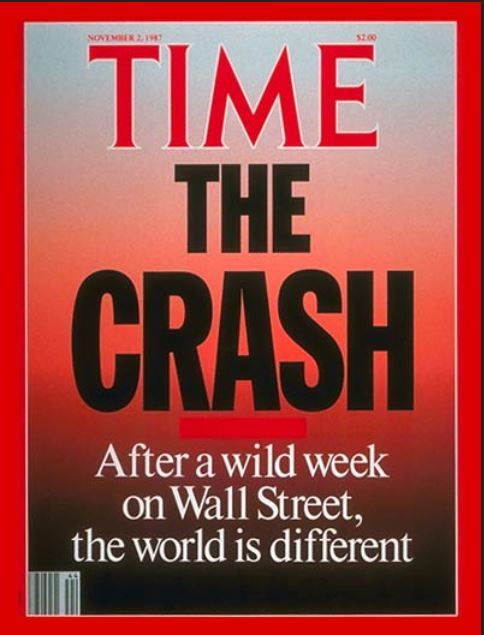
June 13, 2005, Home $weet Home, right before the peak of the housing market:

Or this one just recently. Highly unlikely that The September Issue is dead, but with readership and ad revenues down, perhaps a stern warning regarding the current editorial direction:

What might appear as editorial collusion might simply be like-minded people seeking to be “Stronger Together” (to use a slogan from 2016) as a form of political resistance.
In other words: a herding impulse.
During times of extreme polarization and uncertainty, people naturally seek to align themselves with others of similar persuasion while being certain of only what they’re against. Repeating the same phrases and points has the comforting benefit of reflecting back their own beliefs which adds confidence and reassurance.
As political ideologies spread further apart, the effort to message one’s viewpoint takes on greater importance, even if it means filling the world’s most iconic fashion magazine with political talking points from cover to cover.
Again, the intent is not to judge the politics but to analyze the mood. By getting the “mood” right we can predict the politics. That is why, from a social mood standpoint, the outcome of the 2016 US presidential election was to be expected.
It is quite likely that the current polarization results in part from a monetary extreme: unprecedented stimulus and accommodation by like-minded central banks also seeking to be “Stronger Together.”
“The IMF was part of rebuilding the global economy — we all cooperated in the same endeavor: Rescue the system. That system was severely tested at the beginning of 2008. And that system was rescued and improved thanks to international cooperation, thanks to the belief that we could be stronger together.”
~ Commencement Address by Christine Lagarde, IMF Managing Director Claremont, California May 12, 2018
Extreme monetary policy may have yielded equal and opposing emotional extremes.
While Wall Street is giddy with excess, Main Street senses something is deeply wrong but can’t quite put a finger on it. Divergent opinions then lead to polarization. As Wall Street cheers, Main Street fractures into opposing sides, each seeking an object onto which it can project its angst.
Behold the Donald.
If he espouses Americanism, they want GLOBALISM.
If he wants a wall, they want NO BORDERS.
Behold the two core themes of this year’s September Issue.

As we begin the read through, these themes are abundantly clear. (my comments are lower cased in parentheses. anything in CAPS or bolded is for emphasis).
Repetitive patterns that emerged in order from the front cover to back cover were:
FALL GOES GLOBAL (main cover line sets the stage for the entire issue. also a possible double entendre warning of falling global markets soon)
“EVERYONE’S VOICE COUNTS” (unless you’re Alex Jones, or someone else that Amazon, Google, Instagram, Twitter, or the Facebook doesn’t like. more on this when Beyoncé has her say later on)
Vogue Forces Of Fashion promotion:
MEET THE TRAILBLAZERS PUSHING THE WORLD FORWARD
198, Letter From The Editor:
“September, for us, always starts in March. That’s when we return home from four weeks of shows and start planning what has traditionally always been our biggest issue of the year. Yet the fall 2018 season didn’t feel like it was business as usual, just as life these days doesn’t feel that way either. In all my time editing Vogue, this period is like no other I’ve experienced before, and for good reason: If fashion is radically different, it is because our world is so radically different. As we sat in meetings after the shows, we spent most of our time talking about how what we wear needs to reflect the times it’s being created for. We barely discussed trends -- in fact, trend is now pretty much verboten in the office because it seems such an outdated way to calibrate fashion. Thanks in part to digital technology and social media, we share a growing sense of global citizenship and kinship, not to mention how so many of us are increasingly looking far and wide for labels to better enhance our sense of personal style. Sally Singer, our Creative Digital Director, coined a phrase for it -- “fashion without borders” -- and it is the perfect representation of what this September is all about.
“You’ll find, then, a celebration of the designers who prefer to dispense with the notion of boundaries all together.
“As I read the story that accompanies the portrait of Virgil Abloh, the young Rockford, Illinois-born creative director behind the label Off-White who just made a terrific start with his Louis Vuitton menswear this past June, something Virgil said seemed emblematic of what we wanted to do. ‘It’s like I’m walking down different streets all at the same time, seeing, smelling, and breathing diversity,’ he said, ‘and realizing that things you grow up with -- race, religion, gender, or anything else -- tend to disappear once you’re embedded in a global community.’
“When it came to thinking about who should be on the cover of this September issue, there was really only ever one choice: Beyoncé. It’s not just because her fame redefines what it means to have a global presence; it’s the way she uses that status to challenge herself -- and us, too.
“More important, Beyoncé is intent on challenging the status quo, drawing out attention to society’s imbalances and injustices -- something that many of our current politicians seem intent on maintaining (or, worse, taking us backward).” (again, keep that word “forward” in mind)
Vogue Insiders.com promotion:
A POINT OF VIEW IS MEANT TO BE SHARED. JOIN AND SOUND OFF
Vogue.com promotion:
SHOP THE WORLD
“From museum-worthy boutiques in Tokyo and Milan to rare beauty finds tracked down from halfway around the globe and delivered right to your door, our style is now truly -- and effortlessly -- international.” (“effortlessly” is the tip-off that we’re experiencing a positive mood extreme)
Maybelline ad:
GLOBAL ROMANCE
Cover Girl ad:
I AM WHAT I MAKE UP (ironic given the current “fake news” environment)
254 Taking Flight:
On Vogue.com ==> “The Wing gears up to go GLOBAL” (women-only co-working club with $2350-2700 a year membership fees)
322 Off The Map:
“E-commerce site Ssense is championing the idea that fashion can come from absolutely anywhere.”
“For Ssense, GLOBALISM ISN’T JUST POSITIVE, IT’S PROGRESSIVE.”
334 BAND TOGETHER
356 Star Spangled:
“While knitwear label Alanui is based in Milan, its foray this fall into dressing us head-to-toe embraces a glittery, glam-rock Americana.” (everyone seems to be focusing globally this year)
380 L’Oréal promotion:
BEAUTY BEYOND BORDERS
“Pinging around the globe at the speed of Instagram.”
499 NEW HORIZONS:
“This odyssey is all thanks to the GLOBALLY MINDED designers who simply refuse to see borders.”
500 ALL AROUND THE WORLD
501 HERE, THERE, EVERYWHERE:
“Fashion has never been more celebratory of GLOBAL DIVERSITY and influence as the best fall looks -- and a visionary group of BOUNDARY DEFYING designers -- ably prove.”
506 FIT TO PRINT
(comment: an ironic nod to the daily, front page, hiding-in-plain-sight, bold-faced admission of censorship by the New York Times: “All the News That’s Fit to Print” -- in other words, what’s “fit” is something only they decide. HIDING IN PLAIN SIGHT ironically appears as a caption on page 585)
519 Demna Gvasalia:
“This stars-and-stripes jacket, which represents the States, is my favorite -- because American culture is what I loved when I was growing up.” (another designer with his eyes fixed on distant shores, who now lives in “clean, calm, safely neutral Switzerland” while spray-painting NO BORDERS graffiti on the set of his latest show. the irony is that Switzerland is clean, calm, and safe because it is neutral and has some of the strongest borders in the world)
522 Gosha Ribchinskiy:
“If you’re not thinking GLOBALLY, your thinking is out of date.”
526 Stella McCartney:
“Climate change, of course, knows NO BORDERS.”
Beyoncé In Her Own Words:
“If people in powerful positions continue to hire and cast only people who look like them, sound like them, come from the same neighborhoods they grew up in, they will never have a greater understanding of experiences different from their own. They will hire the same models, curate the same art, cast the same actors over and over again, and we will all lose. The beauty of social media is it’s completely democratic. Everyone has a say. Everyone’s voice counts, and everyone has a chance to paint the world from their own perspective.”
(comment: the most powerful words in the entire magazine. in direct opposition to the Shadow Banners and to Vogue as well for waiting 126 YEARS before an African-American (23-year old Tyler Mitchell) was allowed to shoot its cover, and only when Wintour granted Beyoncé complete control of the cover story and shoot. also notice not one peep of GLOBAL and NO BORDERS talking points in her words)
580 THE GLOBAL TABLE
582 Age Appropriate
“Stories of burnout -- and worse -- are rife in a modeling industry filled with vulnerable mid-teens. So isn’t it time for the fashion world to commit to working with models old enough to vote?”
(another story that is decades too late. but no mention of the European Migrant Rape Crisis against girls (and even boys) as young as twelve. Due to its NO BORDERS policy, Sweden now has the heartbreaking distinction of being labeled the “Rape Capital” of Europe, while victims and their families are labeled racist for speaking out)
586 “Cover Story”
“Is there seduction in concealment? Safety in charade?”
“The incognito chic of the new coverings speaks equally to our desire to conceal -- and that eternal wish to stand out.”
“This predilection to disappear in plain sight is not limited to the catwalks.” Both Rihanna and Beyoncé sported the look during live shows.
(this was probably the only leading-indicator-style, fashion-inspired social mood alert in the issue, and it was all about the trend toward concealment, which is a negative mood characteristic. could also be an unintended consequence of the #MeToo movement as well as the European Migrant Rape Crisis)
=== end of editorial ===
Here is the result when all the noise is stripped away and the thematic messages are linked together in repetition:
FALL GOES GLOBAL, EVERYONE’S VOICE COUNTS, TRAILBLAZERS PUSHING THE WORLD FORWARD. We share a growing sense of global citizenship and kinship, fashion without borders, a celebration of the designers who prefer to dispense with the notion of boundaries all together. Things you grow up with -- race, religion, gender, or anything else -- tend to disappear once you’re embedded in a global community. Fame redefines what it means to have a global presence. A POINT OF VIEW IS MEANT TO BE SHARED. JOIN AND SOUND OFF. SHOP THE WORLD. From museum-worthy boutiques in Tokyo and Milan to rare beauty finds tracked down from halfway around the globe and delivered right to your door, our style is now truly -- and effortlessly -- international. GLOBAL ROMANCE, I AM WHAT I MAKE UP. Taking Flight, Off The Map. Championing the idea that fashion can come from absolutely anywhere. GLOBALISM ISN’T JUST POSITIVE, IT’S PROGRESSIVE, BAND TOGETHER, BEAUTY BEYOND BORDERS. Pinging around the globe at the speed of Instagram. NEW HORIZONS. This odyssey is all thanks to the GLOBALLY MINDED designers who simply refuse to see borders. ALL AROUND THE WORLD, HERE, THERE, EVERYWHERE. Fashion has never been more celebratory of GLOBAL DIVERSITY and influence. A visionary group of BOUNDARY DEFYING designers. FIT TO PRINT. If you’re not thinking GLOBALLY, your thinking is out of date. Climate change, of course, knows NO BORDERS.
Analysis:
Before we jump to the conclusion that this was an intentional messaging strategy, we had better get a few things straight.
First a definition:
Social mood is a shared mental state among humans that arises from social interaction. It is unconscious, unremembered, and endogenously regulated.
~ Socionomic Theory
Therefore, counter-intuitively, what appears as an intentional messaging strategy is likely unconscious.
But the question remains: what does this shared mental state say about current social mood?
We may find the first hint in Anna’s editor’s letter: “If fashion is radically different, it is because our world is so radically different.”
According to the Socionomic Theory of Finance, “humans herd because they evolved to conform to others’ behavior in uncertain situations as a primal survival tactic.”
In my opinion, the Vogue content flagged above is an example of herding as a form of political survival.
“We’re totally integrated here on one floor. It’s total integration and we meet, we discuss, we talk all the time.”
~ Anna Wintour
While caught up in the negative urge to RESIST the current administration, maybe all the ETF meetings, the discussions, and total-integration-all-the-time have resulted in a sort of unconscious groupthink that has allowed Vogue to get swept up in the same positive social mood extreme that has driven the markets to record highs, by unconsciously embracing the same giddy animal spirits fueling Wall Street.
In other words, groupthink may have undermined Vogue’s own message of resistance. GLOBALISM and NO BORDERS are radically extreme aspects of positive social mood.
William H. Whyte Jr. derived the term "groupthink” from George Orwell's Nineteen Eighty-Four, and described it as “rationalized conformity.”
A recent study may have proved its existence. “How social influence can undermine the wisdom of crowd effect,” by Lorenz et al.,¹ found that social interaction among participants produces convergent opinions, less accurate opinions, and higher confidence in those opinions.
“Convergent opinions” may explain the rampant repetition cited above that essentially blurs into a long stream of social mood conformity. “Less accurate opinions” may explain the embrace of GLOBAL/NO BORDERS ideology that was rejected in America and is steadily being rejected throughout Europe, even though the embrace of these ideologies may have resulted from conformity to the same mood underpinning the raging bull market.
Yale psychologist Irving Janis, who pioneered the initial research on the groupthink theory, wrote:
“The main principle of groupthink is this: The more amiability and esprit de corps there is among the members of a policy-making ingroup, the greater the danger that independent critical thinking will be replaced by groupthink, which is likely to result in irrational and dehumanizing actions directed against outgroups.”
Irrational actions directed against outgroups sounds a lot like how Shadow Banning can happen without realizing it is censorship.
Irrational actions directed against outgroups might explain how Search Engine Manipulation happens -- why, when you type in the word “idiot” into Bing, DuckDuckGo, Yahoo, and Google respectively, this is what you get:




Irrational actions directed against outgroups might explain the embrace of NO BORDERS even as Europe is overrun by its Migrant Rape Crisis and No-Go Zones to the point that far-right voters are surging from Norway to Greece and most everywhere in between.
Irrational actions directed against outgroups might also explain how throughout history the word “forward” gets used as a rallying cry for progress even when ideologies linked to it result in regress. Case in point: Venezuela.
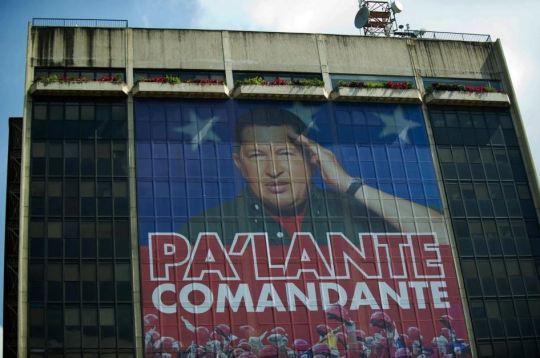
In Latin American slang, Pa’lante is a contraction of "para adelante" or "forward."
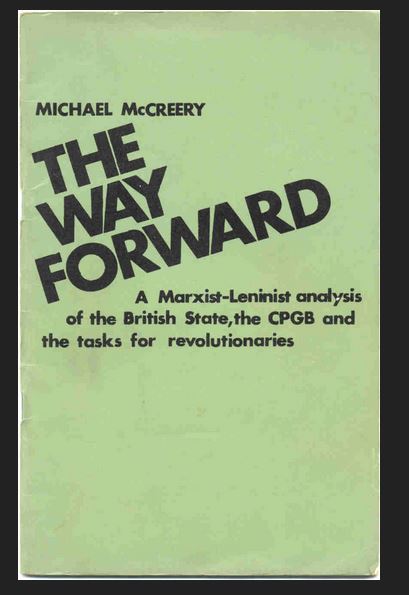

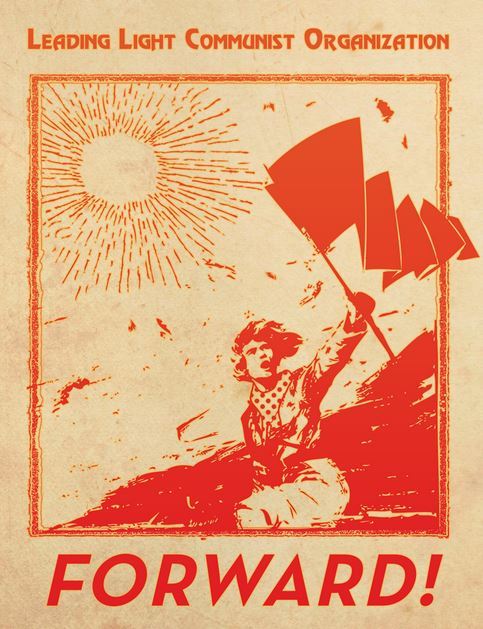
“At Vogue, we’re not much given to looking backward, reasoning that life only goes in one direction -- forward -- and therefore, so should we.”
~ Anna Wintour’s 2017 Editor’s Letter
Zuckerberg’s latest project:

Complete with “Sunset Of Liberty.” (now pulled from site. had to use the Wayback Machine for it from August 30, 2018.)

“Forward” to more voters:

“Demonizing immigrants weakens our country. Fighting against hate crimes makes us grow stronger together.”
~ George Soros

In summary, GLOBALISM and NO BORDERS are positive mood manifestations. Constant, effortless travel and a miche mache of global styles reflect an expansionist mood peak at odds with growing angst against income equality resulting from extreme monetary policy.
The irony is that income equality is often blamed on capitalism when a central bank and a progressive income tax are two of the ten planks of the Communist Manifesto.
And here’s what all that miche mache global style looks like: not very coherent, like a bunch of “convergent opinions.” Anna even referred to it as the “creativity of chaos . . . everything all sort of jumbled up and looking like it came from different countries and different identities.”




GLOBAL/NO BORDERS, effortless travel, pinging around the world at the speed of Instagram . . . this is what maximum mood expansion sounds like.
Incidentally there is so much demand for air travel lately that JetBlue and United have just raised checked bag fees, again.
And this is what maximum mood expansion looks like:

Here are some other examples:
S&P 500 revenues at record highs.
S&P 500 earnings at record highs.
S&P 500 profit margin at record highs.
GDP revised up to 4.2%.
US consumer confidence at 18-year highs.
Highest job satisfaction reading since 2005.
Lowest unemployment rate in almost 50 years.
Recent headlines:
Luxury Lounge Wars Heat Up as Airlines Vie for High-end Passengers
Luxury Housing is Hot, Hot, Hot
Personal Loans Surge to a Record High
A record 95% of American manufacturers recently declared themselves optimistic about the economy
The Art Fair where $20 million Impulse Buys are the New Normal
At $9.7 Million a Pop, Private Jets are Luring Buyers Again
Home Price Insanity: $2.6 Million for 900 Square Feet
But probably my favorite dead-simple, long-term forecasting tool is the S&P/Case-Shiller 10-City Composite Home Price Index. This has me looking for another bump in the road before a run to final highs in possibly 2021-2022 which should coincide with further highs in stocks.

Thus, the march “forward” will likely be slow until we reach a depression when it will once again be a rallying cry for the “economically oppressed.”
Sadly, then capitalism will likely get the blame for our day of reckoning even though it was central banking (central planning) that created the imbalances that needed to be corrected.
The negative mood forces that ushered in Trump’s victory have given way to euphoria, but angst is still smoldering here and abroad as evidenced by Europe’s far-right resurgence with anti-immigration as its core ideal. Since we are all now riding the same liquidity wave, we should pay close attention to other markets as well.
Therefore, the observations made in last year’s September Vogue Mood Report still stand: authoritarianism may still be on its way as countries “crack down” on loose borders.
Socialism in America will probably have to wait until after the excesses have been purged from the system and the jackboots fill the streets. Then, “forward” might seem like the only way for many.
Vogue is warning us of a potentially significant mood peak and thus the potential for a significant market peak. But it is still possible that higher highs can be made based on pure momentum, even after another period of adjustment.
Positive social mood can also feed on momentum, so expect higher until it flames out. You can always check with Mood Report for market timing.
On the other side, social mood is sky-high even as negative aspects of it continue to build beneath the wave.
This is most likely because of the degree of the potential peak at hand. Like a cresting tidal wave, the crest itself may take a long time to form, but meanwhile below the surface the energy is building for the wave to roll over and crush the unexpecting. Likewise with social mood. As with the interplay of yin and yang, excesses in one yield excesses in the other as the opposing forces remain in flux at all times.
I have tried to avoid making this report a political diatribe, but instead have attempted to show that we are at the whims of social mood. The best we can do is identify it and try to either accept it or align with it as best we can. Social mood dictates the mode of events, not the events themselves. We can only control our reactions.
Thanks for reading.
References
¹ Lorenz, J., Rauhut, F. Schweitzer and D. Helbing, “How Social Influence Can Undermine the Wisdom of Crowd Effect,” Proceedings of the National Academy of Sciences, 2011.
1 note
·
View note